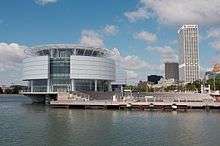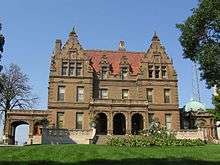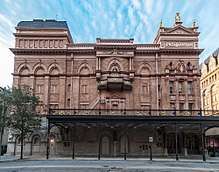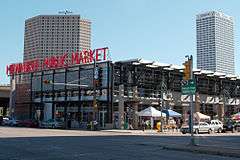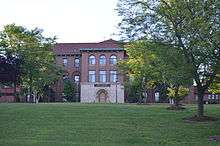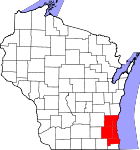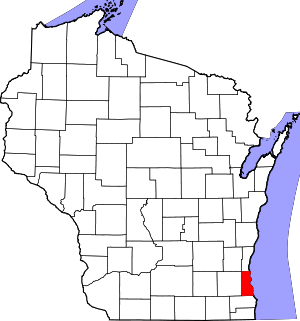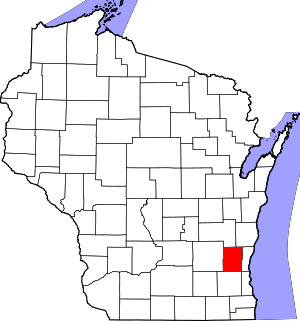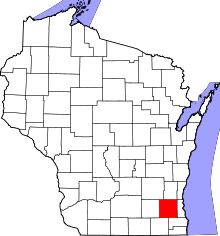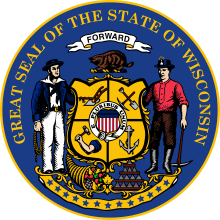Milwaukee
Milwaukee (/mɪlˈwɔːki/, locally /mɪˈ-/)[5] is the largest city in the state of Wisconsin and the fifth-largest city in the Midwestern United States. The seat of Milwaukee County, it is on Lake Michigan's western shore. Ranked by its estimated 2018 population, Milwaukee was the 31st largest city in the United States.[6] The city's estimated population in 2019 was 590,157.[2] Milwaukee is the main cultural and economic center of the Milwaukee metropolitan area which had a population of 2,043,904 in the 2014 census estimate. It is the fourth-most densely populated metropolitan area in The Midwest, surpassed only by Chicago, Minneapolis-St. Paul and Detroit, respectively.[7] Milwaukee is considered a Gamma global city as categorized by the Globalization and World Cities Research Network with a regional GDP of over $105 billion.
Milwaukee, Wisconsin | |
|---|---|
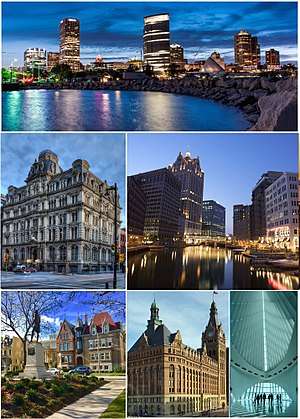 Clockwise from top: Milwaukee skyline from Discovery World, downtown at night along the Milwaukee Riverwalk, inside the Milwaukee Art Museum, Milwaukee City Hall, Burns Commons in the East Side neighborhood, and the historic Mitchell Building | |
 Logo | |
| Nickname(s): Cream City, Brew City, Beer City, Brew Town, Beertown, Miltown, The Mil, MKE, The City of Festivals, Deutsch-Athen (German Athens), The Four, The 414 | |
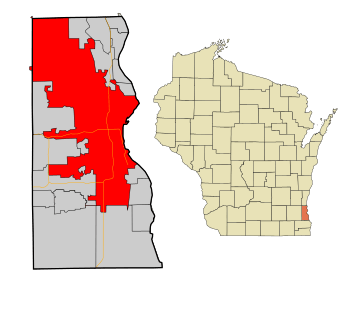 Location within Milwaukee County | |
 Milwaukee Location within Wisconsin  Milwaukee Location within the United States | |
| Coordinates: 43.05°N 87.95°W | |
| Country | United States |
| State | Wisconsin |
| Counties | Milwaukee, Washington, Waukesha |
| Incorporated | January 31, 1846 |
| Government | |
| • Type | Strong mayor-council |
| • Mayor | Tom Barrett (D) |
| Area | |
| • City | 96.81 sq mi (250.75 km2) |
| • Land | 96.18 sq mi (249.12 km2) |
| • Water | 0.63 sq mi (1.63 km2) |
| Elevation | 617 ft (188 m) |
| Population | |
| • City | 594,833 |
| • Estimate (2019)[2] | 590,157 |
| • Rank | US: 31st WI: 1st |
| • Density | 6,135.71/sq mi (2,369.01/km2) |
| • Urban | 1,376,476 (US: 35th) |
| • Metro | 1,572,245 (US: 39th) |
| • CSA | 2,043,904 (US: 29th) |
| Demonym(s) | Milwaukeean |
| Time zone | UTC−6 (CST) |
| • Summer (DST) | UTC−5 (CDT) |
| ZIP Codes | 53172, 53201–53216, 53218–53228, 53233–53234, 53237, 53259, 53263, 53267–53268, 53274, 53278, 53288, 53290, 53293, 53295 |
| Area code(s) | 414 |
| FIPS code | 55-53000[3] |
| GNIS feature ID | 1577901[4] |
| Major airport | Milwaukee Mitchell International Airport (MKE) |
| Interstates | |
| U.S. Routes | |
| Website | city |
The first Europeans to pass through the area were French Catholic Jesuit missionaries, who were ministering to Native Americans, and fur traders. In 1818, the French Canadian explorer Solomon Juneau settled in the area, and in 1846, Juneau's town combined with two neighboring towns to incorporate as the city of Milwaukee. Large numbers of German immigrants arrived during the late 1840s, after the German revolutions, with Poles and other eastern European immigrants arriving in the following decades. Milwaukee is known for its brewing traditions that began with the German immigrants.
Beginning in the early 21st century, the city has been undergoing its largest construction boom since the 1960s.[8] Major new additions to the city in the past two decades include the Milwaukee Riverwalk, the Wisconsin Center, Miller Park, The Hop (streetcar system), an expansion to the Milwaukee Art Museum, Milwaukee Repertory Theater, and Pier Wisconsin, as well as major renovations to the UW–Milwaukee Panther Arena. The Fiserv Forum opened in late 2018 and hosts sporting events and concerts. Summerfest, the largest music festival in the world, is also a large economic engine and cultural attraction for the city. In 2018, Milwaukee was named "The Coolest City in the Midwest" by Vogue magazine.
History
Name
The name "Milwaukee" comes from an Algonquian word millioke, meaning "good", "beautiful" and "pleasant land" (compare Potawatomi: minwaking, Ojibwe: ominowakiing) or "gathering place [by the water]" (compare Potawatomi: manwaking, Ojibwe: omaniwakiing).[9][10] The name has a less pleasant connotation in the Menominee language, where it is called Māēnāēwah, "some misfortune happens".[11]
Native American Milwaukee
Indigenous cultures lived along the waterways for thousands of years. The first recorded inhabitants of the Milwaukee area are the historic Menominee, Fox, Mascouten, Sauk, Potawatomi, and Ojibwe (all Algic/Algonquian peoples); and Ho-Chunk (Winnebago, a Siouan people) Native American tribes. Many of these people had lived around Green Bay[12] before migrating to the Milwaukee area around the time of European contact.
In the second half of the 18th century, the Native Americans living near Milwaukee played a role in all the major European wars on the American continent. During the French and Indian War, a group of "Ojibwas and Pottawattamies from the far [Lake] Michigan" (i.e., the area from Milwaukee to Green Bay) joined the French-Canadian Daniel Liénard de Beaujeu at the Battle of the Monongahela.[13] In the American Revolutionary War, the Native Americans around Milwaukee were some of the few groups to ally with the rebel Continentals.[14]
After the Revolutionary War, the Native Americans fought the United States in the Northwest Indian War as part of the Council of Three Fires. During the War of 1812, they held a council in Milwaukee in June 1812, which resulted in their decision to attack Chicago[15] in retaliation against American expansion. This resulted in the Battle of Fort Dearborn on August 15, 1812, the only known armed conflict in the Chicago area. This battle convinced the American government that the Native Americans had to be removed from their land. After being attacked in the Black Hawk War in 1832, the Native Americans in Milwaukee signed the Treaty of Chicago with the United States in 1833. In exchange for their ceding their lands in the area, they were to receive monetary payments and lands west of the Mississippi in Indian Territory.
Milwaukee since European settlement
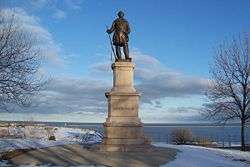
Europeans had arrived in the Milwaukee area prior to the 1833 Treaty of Chicago. French missionaries and traders first passed through the area in the late 17th and 18th centuries. Alexis Laframboise, in 1785, coming from Michilimackinac (now in Michigan) settled a trading post; and is considered the first resident of European descent in the Milwaukee region.[16] Early explorers called the Milwaukee River and surrounding lands various names: Melleorki, Milwacky, Mahn-a-waukie, Milwarck, and Milwaucki, in efforts to transliterate the native terms. For many years, printed records gave the name as "Milwaukie".
One story on the origin of Milwaukee's name says,
[O]ne day during the thirties of the last century [1800s] a newspaper calmly changed the name to Milwaukee, and Milwaukee it has remained until this day.[17]
The spelling "Milwaukie" lives on in Milwaukie, Oregon, named after the Wisconsin city in 1847, before the current spelling was universally accepted.
Milwaukee has three "founding fathers": Solomon Juneau, Byron Kilbourn, and George H. Walker. Solomon Juneau was the first of the three to come to the area, in 1818. He founded a town called Juneau's Side, or Juneautown, that began attracting more settlers. In competition with Juneau, Byron Kilbourn established Kilbourntown west of the Milwaukee River. He ensured the roads running toward the river did not join with those on the east side. This accounts for the large number of angled bridges that still exist in Milwaukee today.[18] Further, Kilbourn distributed maps of the area which only showed Kilbourntown, implying Juneautown did not exist or the river's east side was uninhabited and thus undesirable. The third prominent developer was George H. Walker. He claimed land to the south of the Milwaukee River, along with Juneautown, where he built a log house in 1834. This area grew and became known as Walker's Point.
The first large wave of settlement to the areas that would later become Milwaukee County and the City of Milwaukee began in 1835, following removal of the tribes in the Council of Three Fires. Early that year it became known that Juneau and Kilbourn intended to lay out competing town-sites. By the year's end both had purchased their lands from the government and made their first sales. There were perhaps 100 new settlers in this year, mostly from New England and other Eastern states. On September 17, 1835, the first election was held in Milwaukee; the number of votes cast was 39.[19]
By 1840, the three towns had grown, along with their rivalries. There were intense battles between the towns, mainly Juneautown and Kilbourntown, which culminated with the Milwaukee Bridge War of 1845. Following the Bridge War, town leaders decided the best course of action was to officially unite the towns. So, on January 31, 1846, they combined to incorporate as the City of Milwaukee and elected Solomon Juneau as Milwaukee's first mayor.[20]
._loc_call_no_g4124m-pm010450.jpg)
Milwaukee began to grow as a city as high numbers of immigrants, mainly German, made their way to Wisconsin during the 1840s and 1850s. Scholars classify German immigration to the United States in three major waves, and Wisconsin received a significant number of immigrants from all three. The first wave from 1845 to 1855 consisted mainly of people from Southwestern Germany, the second wave from 1865 to 1873 concerned primarily Northwestern Germany, while the third wave from 1880 to 1893 came from Northeastern Germany.[21] In the 1840s, the number of people who left German-speaking lands was 385,434, in the 1850s it reached 976,072, and an all-time high of 1.4 million immigrated in the 1880s. In 1890, the 2.78 million first-generation German Americans represented the second-largest foreign-born group in the United States. Of all those who left the German lands between 1835 and 1910, 90 percent went to the United States, most of them traveling to the Mid-Atlantic states and the Midwest.[21]
By 1900 34 percent of Milwaukee's population was of German background.[21] The largest number of German immigrants to Milwaukee came from Prussia, followed by Bavaria, Saxony, Hanover, and Hesse-Darmstadt. Milwaukee gained its reputation as the most German of American cities not just from the large number of German immigrants it received, but for the sense of community which the immigrants established here.[22]
Most German immigrants came to Wisconsin in search of inexpensive farmland.[22] However, immigration began to change in character and size in the late 1840s and early 1850s, due to the 1848 revolutionary movements in Europe.[23] After 1848, hopes for a united Germany had failed, and revolutionary and radical Germans, known as the "Forty-Eighters", turned their attention to the United States.
One of the most famous "liberal revolutionaries" of 1848 was Carl Schurz. He later explained in 1854 why he came to Milwaukee,
"It is true, similar things [cultural events and societies] were done in other cities where the Forty-eighters [sic] had congregated. But so far as I know, nowhere did their influence so quickly impress itself upon the whole social atmosphere as in 'German Athens of America' as Milwaukee was called at the time."[24]
Schurz was referring to the various clubs and societies Germans developed in Milwaukee. The pattern of German immigrants to settle near each other encouraged the continuation of German lifestyle and customs. This resulted in German language organizations that encompassed all aspects of life; for example, singing societies and gymnastics clubs. Germans also had a lasting influence on the American school system. Kindergarten was created as a pre-school for children, and sports programs of all levels, as well as music and art were incorporated as elements of the regular school curriculum. These ideas were first introduced by radical-democratic German groups, such as the Socialist Turner Societies, known today as the American Turners. Specifically in Milwaukee, the American Turners established its own Normal College for teachers of physical education and a German-English Academy.[25]
Milwaukee's German element is still strongly present today. The city celebrates its German culture by annually hosting a German Fest in July and an Oktoberfest in October. Milwaukee boasts a number of German restaurants, as well as a traditional German beer hall. A German language immersion school is offered for children in grades K-5.[26]
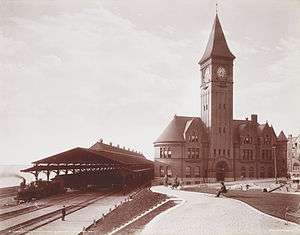
Although the German presence in Milwaukee after the Civil War remained strong and their largest wave of immigrants had yet to land, other groups also made their way to the city. Foremost among these were Polish immigrants. The Poles had many reasons for leaving their homeland, mainly poverty and political oppression. Because Milwaukee offered the Polish immigrants an abundance of low-paying entry level jobs, it became one of the largest Polish settlements in the USA.
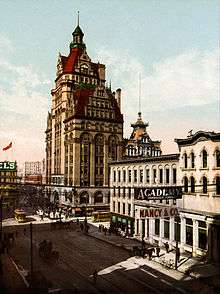
For many residents, Milwaukee's South Side is synonymous with the Polish community that developed here. The group maintained a high profile here for decades, and it was not until the 1950s and 1960s that families began to disperse to the southern suburbs.
By 1850, there were seventy-five Poles in Milwaukee County and the US Census shows they had a variety of occupations: grocers, blacksmiths, tavernkeepers, coopers, butchers, broommakers, shoemakers, draymen, laborers, and farmers. Three distinct Polish communities evolved in Milwaukee, with the majority settling in the area south of Greenfield Avenue. Milwaukee County's Polish population of 30,000 in 1890 rose to 100,000 by 1915. Poles historically have had a strong national cultural and social identity, maintained through the Catholic Church. A view of Milwaukee's South Side skyline is replete with the steeples of the many churches these immigrants built that are still vital centers of the community.
St. Stanislaus Catholic Church and the surrounding neighborhood was the center of Polish life in Milwaukee. As the Polish community surrounding St. Stanislaus continued to grow, Mitchell Street became known as the "Polish Grand Avenue". As Mitchell Street grew more dense, the Polish population started moving south to the Lincoln Village neighborhood, home to the Basilica of St. Josaphat and Kosciuszko Park. Other Polish communities started on the east side of Milwaukee. Jones Island was a major commercial fishing center settled mostly by Poles from around the Baltic Sea.
Milwaukee has the fifth-largest Polish population in the U.S. at 45,467, ranking behind New York City (211,203), Chicago (165,784), Los Angeles (60,316) and Philadelphia (52,648).[27] The city holds Polish Fest, an annual celebration of Polish culture and cuisine.[28]
In addition to the Germans and Poles, Milwaukee received a large influx of other European immigrants from Lithuania, Italy, Ireland, France, Russia, Bohemia and Sweden, who included Jews, Lutherans, and Catholics. Italian Americans total 16,992 in the city, but in Milwaukee County, they number at 38,286.[27] The largest Italian-American festival in the area, Festa Italiana, is held in the city.[29] By 1910, Milwaukee shared the distinction with New York City of having the largest percentage of foreign-born residents in the United States.[30] In 1910, whites represented 99.7% of the city's total population of 373,857.[31] Milwaukee has a strong Greek Orthodox Community, many of whom attend the Greek Orthodox Church on Milwaukee's northwest side, designed by Wisconsin-born architect Frank Lloyd Wright. Milwaukee has a sizable Croatian population, with Croatian churches and their own historic and successful soccer club The Croatian Eagles at the 30-acre Croatian Park in Franklin, Wisconsin.
Milwaukee also has a large Serbian population, who have developed Serbian restaurants, a Serbian K-8 School, and Serbian churches, along with an American Serb Hall. The American Serb Hall in Milwaukee is known for its Friday fish fries and popular events. Many U.S. presidents have visited Milwaukee's Serb Hall in the past. The Bosnian population is growing in Milwaukee as well due to late-20th century immigration after the war in Bosnia-Herzegovina.
During this time, a small community of African Americans migrated from the South in the Great Migration. They settled near each other, forming a community that came to be known as Bronzeville. As industry boomed, more migrants came and African-American influence grew in Milwaukee.
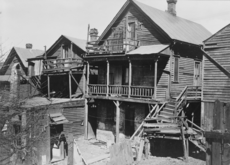
By 1925, around 9,000 Mexicans lived in Milwaukee, but the Great Depression forced many of them to move back south. In the 1950s, the Hispanic community was beginning to emerge. They arrived for jobs, filling positions in the manufacturing and agricultural sectors. During this time there were labor shortages due to the immigration laws that had reduced immigration from eastern and southern Europe. Additionally, strikes contributed to the labor shortages.[32]
During the first sixty years of the 20th century, Milwaukee was the major city in which the Socialist Party of America earned the highest votes. Milwaukee elected three mayors who ran on the ticket of the Socialist Party: Emil Seidel (1910–1912), Daniel Hoan (1916–1940), and Frank Zeidler (1948–1960). Often referred to as "Sewer Socialists", the Milwaukee Socialists were characterized by their practical approach to government and labor.
Historic neighborhoods
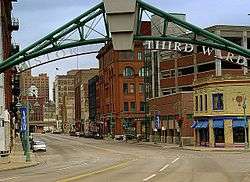
In 1892, Whitefish Bay, South Milwaukee, and Wauwatosa were incorporated. They were followed by Cudahy (1895), North Milwaukee (1897) and East Milwaukee, later known as Shorewood, in 1900. In the early 20th century West Allis (1902), and West Milwaukee (1906) were added, which completed the first generation of "inner-ring" suburbs.
In the 1920s, Chicago gangster activity came north to Milwaukee during the Prohibition era. Al Capone, noted Chicago mobster, owned a home in the Milwaukee suburb Brookfield, where moonshine was made. The house still stands on a street named after Capone.[33]
By 1960, Milwaukee had grown to become one of the largest cities in the United States. Its population peaked at 741,324. In 1960, the Census Bureau reported city's population as 91.1% white and 8.4% black.[34]
By the late 1960s, Milwaukee's population had started to decline as people moved to suburbs, aided by federal subsidies of highways. They moved to take advantage of new housing.[35] Milwaukee had a population of 594,833 by 2010, while the population of the overall metropolitan area increased. Given its large immigrant population and historic neighborhoods, Milwaukee avoided the severe declines of some of its fellow "Rust Belt" cities.
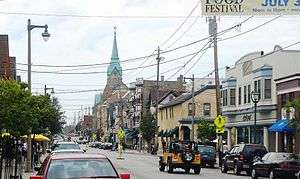
Since the 1980s, the city has begun to make strides in improving its economy, neighborhoods, and image, resulting in the revitalization of neighborhoods such as the Historic Third Ward, Lincoln Village, the East Side, and more recently Walker's Point and Bay View, along with attracting new businesses to its downtown area. These efforts have substantially slowed the population decline and have stabilized many parts of Milwaukee.
Milwaukee's European history is evident today. Largely through its efforts to preserve its history, Milwaukee was named one of the "Dozen Distinctive Destinations" by the National Trust for Historic Preservation in 2006.[36]
Historic Milwaukee walking tours provide a guided tour of Milwaukee's historic districts, including topics on Milwaukee's architectural heritage, its glass skywalk system, and the Milwaukee Riverwalk.

Geography
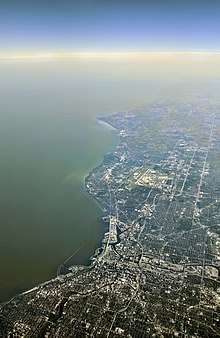
Milwaukee lies along the shores and bluffs of Lake Michigan at the confluence of three rivers: the Menomonee, the Kinnickinnic, and the Milwaukee. Smaller rivers, such as the Root River and Lincoln Creek, also flow through the city.
Milwaukee's terrain is sculpted by the glacier path and includes steep bluffs along Lake Michigan that begin about a mile (1.6 km) north of downtown. In addition, 30 miles (48 km) southwest of Milwaukee is the Kettle Moraine and lake country that provides an industrial landscape combined with inland lakes.
According to the United States Census Bureau, the city has a total area of 96.80 square miles (250.71 km2), of which, 96.12 square miles (248.95 km2) is land and 0.68 square miles (1.76 km2) is water.[37] The city is overwhelmingly (99.89% of its area) in Milwaukee County, but there are two tiny unpopulated parts of it that extend into neighboring counties. The part in Washington County is bordered by the southeast corner of Germantown, while the part in Waukesha County is bordered by the southeast corner of Menomonee Falls, north of the village of Butler. Both were annexations done for industrial concerns, with the Waukesha County portion containing a Cargill plant for Ambrosia Chocolate, and the Washington County portion containing a Waste Management facility.
Cityscape
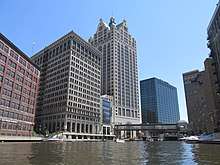
North–south streets are numbered, and east–west streets are named. However, north–south streets east of 1st Street are named, like east–west streets. The north–south numbering line is along the Menomonee River (east of Hawley Road) and Fairview Avenue/Golfview Parkway (west of Hawley Road), with the east–west numbering line defined along 1st Street (north of Oklahoma Avenue) and Chase/Howell Avenue (south of Oklahoma Avenue). This numbering system is also used to the north by Mequon in Ozaukee County, and by some Waukesha County communities.
Milwaukee is crossed by Interstate 43 and Interstate 94, which come together downtown at the Marquette Interchange. The Interstate 894 bypass (which as of May 2015 also contains Interstate 41) runs through portions of the city's southwest side, and Interstate 794 comes out of the Marquette interchange eastbound, bends south along the lakefront and crosses the harbor over the Hoan Bridge, then ends near the Bay View neighborhood and becomes the "Lake Parkway" (WIS-794).
One of the distinctive traits of Milwaukee's residential areas are the neighborhoods full of so-called Polish flats. These are two-family homes with separate entrances, but with the units stacked one on top of another instead of side-by-side. This arrangement enables a family of limited means to purchase both a home and a modestly priced rental apartment unit. Since Polish-American immigrants to the area prized land ownership, this solution, which was prominent in their areas of settlement within the city, came to be associated with them.
The tallest building in the city is the U.S. Bank Center.
Climate
Milwaukee's location in the Great Lakes Region often has rapidly changing weather, producing a humid continental climate (Köppen Dfa), with cold, windy, snowy winters, and warm, humid summers. The warmest month of the year is July, when the 24-hour average is 71.8 °F (22.1 °C), while January is the coldest month, with a 24-hour average of 22.3 °F (−5.4 °C).[38]
Because of Milwaukee's proximity to Lake Michigan, a convection current forms around mid-afternoon in light wind, resulting in the so-called "lake breeze" – a smaller scale version of the more common sea breeze. The lake breeze is most common between the months of March and July. This onshore flow causes cooler temperatures to move inland usually 5 to 15 miles (8 to 24 km), with much warmer conditions persisting further inland. Because Milwaukee's official climate site, Milwaukee Mitchell International Airport, is only 3 miles (4.8 km) from the lake, seasonal temperature variations are less extreme than in many other locations of the Milwaukee metropolitan area.
As the sun sets, the convection current reverses and an offshore flow ensues causing a land breeze. After a land breeze develops, warmer temperatures flow east toward the lakeshore, sometimes causing high temperatures during the late evening. The lake breeze is not a daily occurrence and will not usually form if a southwest, west, or northwest wind generally exceeds 15 mph (24 km/h). The lake moderates cold air outbreaks along the lakeshore during winter months.
Aside from the lake's influence, overnight lows in downtown Milwaukee year-round are often much warmer than suburban locations because of the urban heat island effect. Onshore winds elevate daytime relative humidity levels in Milwaukee as compared to inland locations nearby.
Thunderstorms in the region can be dangerous and damaging, bringing hail and high winds. In rare instances, they can bring a tornado. However, almost all summer rainfall in the city is brought by these storms. In spring and fall, longer events of prolonged, lighter rain bring most of the precipitation. A moderate snow cover can be seen on or linger for many winter days, but even during meteorological winter, on average, over 40% of days see less than 1 inch (2.5 cm) on the ground.[39]
Milwaukee tends to experience highs that are 90 °F (32 °C) on or above seven days per year, and lows at or below 0 °F (−18 °C) on six to seven nights.[39] Extremes range from 105 °F (41 °C) set on July 24, 1934 down to −26 °F (−32 °C) on both January 17, 1982 and February 4, 1996.[40] The 1982 event, also known as Cold Sunday, featured temperatures as low as −40 °F (−40 °C) in some of the suburbs as little as 10 miles (16 km) to the north of Milwaukee.
| Climate data for Milwaukee (Mitchell International Airport), 1981–2010 normals,[lower-alpha 1] extremes 1871–present[lower-alpha 2] | |||||||||||||
|---|---|---|---|---|---|---|---|---|---|---|---|---|---|
| Month | Jan | Feb | Mar | Apr | May | Jun | Jul | Aug | Sep | Oct | Nov | Dec | Year |
| Record high °F (°C) | 63 (17) |
71 (22) |
84 (29) |
91 (33) |
95 (35) |
104 (40) |
105 (41) |
103 (39) |
99 (37) |
89 (32) |
77 (25) |
68 (20) |
105 (41) |
| Mean maximum °F (°C) | 48.4 (9.1) |
51.6 (10.9) |
68.6 (20.3) |
79.6 (26.4) |
85.1 (29.5) |
92.3 (33.5) |
93.7 (34.3) |
91.8 (33.2) |
87.3 (30.7) |
78.5 (25.8) |
65.0 (18.3) |
51.3 (10.7) |
95.5 (35.3) |
| Average high °F (°C) | 28.9 (−1.7) |
32.5 (0.3) |
42.4 (5.8) |
53.8 (12.1) |
64.9 (18.3) |
75.3 (24.1) |
80.1 (26.7) |
78.5 (25.8) |
71.3 (21.8) |
59.3 (15.2) |
46.0 (7.8) |
32.8 (0.4) |
55.6 (13.1) |
| Average low °F (°C) | 15.6 (−9.1) |
19.3 (−7.1) |
27.7 (−2.4) |
37.3 (2.9) |
46.5 (8.1) |
57.1 (13.9) |
63.5 (17.5) |
63.0 (17.2) |
54.9 (12.7) |
43.2 (6.2) |
32.0 (0.0) |
20.1 (−6.6) |
40.1 (4.5) |
| Mean minimum °F (°C) | −5.1 (−20.6) |
0.4 (−17.6) |
10.9 (−11.7) |
24.7 (−4.1) |
35.7 (2.1) |
45.0 (7.2) |
53.2 (11.8) |
53.4 (11.9) |
40.7 (4.8) |
29.9 (−1.2) |
17.4 (−8.1) |
0.1 (−17.7) |
−10.2 (−23.4) |
| Record low °F (°C) | −26 (−32) |
−26 (−32) |
−10 (−23) |
12 (−11) |
21 (−6) |
33 (1) |
40 (4) |
42 (6) |
28 (−2) |
15 (−9) |
−14 (−26) |
−22 (−30) |
−26 (−32) |
| Average precipitation inches (mm) | 1.76 (45) |
1.65 (42) |
2.27 (58) |
3.56 (90) |
3.40 (86) |
3.90 (99) |
3.67 (93) |
3.97 (101) |
3.18 (81) |
2.65 (67) |
2.71 (69) |
2.04 (52) |
34.76 (883) |
| Average snowfall inches (cm) | 14.7 (37) |
9.8 (25) |
7.0 (18) |
2.0 (5.1) |
0.1 (0.25) |
0 (0) |
0 (0) |
0 (0) |
0 (0) |
0.3 (0.76) |
2.4 (6.1) |
10.6 (27) |
46.9 (119) |
| Average precipitation days (≥ 0.01 in) | 11.4 | 9.7 | 11.4 | 12.1 | 11.4 | 10.4 | 9.8 | 9.5 | 8.8 | 10.0 | 11.3 | 10.9 | 126.7 |
| Average snowy days (≥ 0.1 in) | 9.8 | 7.5 | 5.6 | 1.7 | 0.1 | 0 | 0 | 0 | 0 | 0.3 | 2.5 | 7.8 | 35.3 |
| Average relative humidity (%) | 72.3 | 71.9 | 71.4 | 68.5 | 68.5 | 69.7 | 71.5 | 74.9 | 75.4 | 72.5 | 74.5 | 75.9 | 72.3 |
| Average dew point °F (°C) | 11.7 (−11.3) |
15.4 (−9.2) |
24.6 (−4.1) |
33.6 (0.9) |
43.7 (6.5) |
54.3 (12.4) |
60.6 (15.9) |
60.4 (15.8) |
53.4 (11.9) |
41.4 (5.2) |
30.4 (−0.9) |
18.3 (−7.6) |
37.3 (3.0) |
| Mean monthly sunshine hours | 140.2 | 151.5 | 185.4 | 213.5 | 275.5 | 304.5 | 321.1 | 281.2 | 215.1 | 178.0 | 112.8 | 104.8 | 2,483.6 |
| Percent possible sunshine | 48 | 51 | 50 | 53 | 61 | 66 | 69 | 65 | 57 | 52 | 38 | 37 | 56 |
| Average ultraviolet index | 1 | 2 | 4 | 5 | 7 | 8 | 8 | 8 | 6 | 3 | 2 | 1 | 5 |
| Source 1: NOAA (relative humidity, dew point, and sun 1961–1990)[40][41][39][42] | |||||||||||||
| Source 2: Weather Atlas [43] | |||||||||||||
| Climate data for Milwaukee | |||||||||||||
|---|---|---|---|---|---|---|---|---|---|---|---|---|---|
| Month | Jan | Feb | Mar | Apr | May | Jun | Jul | Aug | Sep | Oct | Nov | Dec | Year |
| Average sea temperature °F (°C) | 37.5 (3.0) |
36.0 (2.2) |
36.2 (2.4) |
38.2 (3.4) |
40.8 (4.9) |
53.3 (11.8) |
67.9 (19.9) |
71.9 (22.2) |
66.9 (19.4) |
54.9 (12.8) |
46.9 (8.3) |
40.1 (4.5) |
49.2 (9.6) |
| Source: Weather Atlas [43] | |||||||||||||
Climate change
According to the United States' Environmental Protection Agency, Milwaukee is threatened by ongoing climate change which is warming the planet. These risk include worsened heat waves because many of its residents do not possess air conditioners, concerns about the water quality of Lake Michigan, and increased chances of flooding from intense rainstorms.[44] In 2018, Milwaukee's mayor Tom Barrett announced that the city would uphold its obligations under the Paris Agreement, despite the United States' withdrawal, and set a goal moving a quarter of the city's electricity sources to renewable energy by 2025. These have included expansions in the city's solar power-generating capacity and a wind turbine's installation near the Port of Milwaukee. Other actions being taken include local incentives for energy-saving upgrades to homes and businesses.[45]
Water
In the 1990s and 2000s, Lake Michigan experienced large algae blooms, which can threaten aquatic life. Responding to this problem, in 2009 the city became an "Innovating City" in the Global Compact Cities Program. The Milwaukee Water Council was also formed in 2009.[46] Its objectives were to "better understand the processes related to freshwater systems dynamics" and to develop "a policy and management program aimed at balancing the protection and utilization of freshwater". The strategy used the Circles of Sustainability method. Instead of treating the water quality problem as a single environmental issue, the Water Council draws on the Circles method to analyze the interconnection among ecological, economic, political and cultural factors.[47] This holistic water treatment helped Milwaukee win the US Water Alliance's 2012 US Water Prize.[48]
Demographics
| Historical population | |||
|---|---|---|---|
| Census | Pop. | %± | |
| 1840 | 1,700 | — | |
| 1850 | 20,061 | 1,080.1% | |
| 1860 | 45,246 | 125.5% | |
| 1870 | 71,440 | 57.9% | |
| 1880 | 115,587 | 61.8% | |
| 1890 | 204,468 | 76.9% | |
| 1900 | 285,315 | 39.5% | |
| 1910 | 373,857 | 31.0% | |
| 1920 | 457,147 | 22.3% | |
| 1930 | 578,249 | 26.5% | |
| 1940 | 587,472 | 1.6% | |
| 1950 | 637,392 | 8.5% | |
| 1960 | 741,324 | 16.3% | |
| 1970 | 717,099 | −3.3% | |
| 1980 | 636,212 | −11.3% | |
| 1990 | 628,088 | −1.3% | |
| 2000 | 596,974 | −5.0% | |
| 2010 | 594,833 | −0.4% | |
| Est. 2019 | 590,157 | [2] | −0.8% |
| U.S. Decennial Census[49] 2018 Estimate[50] | |||
According to the 2013 U.S. Census Estimate, 599,164 people were living in Milwaukee.[51] As of 2000, 135,133 families resided in 232,188 Milwaukee households. The population density was 2,399.5/km2 (6,214.3 per square mile). There were 249,225 housing units at an average density of 1,001.7/km2 (2,594.4 per square mile).
Milwaukee is the 31st most populous city in the United States, and anchors the 39th most populous Metropolitan Statistical Area in the United States. Its combined statistical area population makes it the 29th most populous Combined Statistical Area of the United States. In 2012, Milwaukee was listed as a gamma global city by the Globalization and World Cities Research Network.
2010 Census
About 30.5% of households in 2000 had children under the age of 18 living with them. 32.2% of households were married couples living together, 21.1% had a female householder with no husband present, and 41.8% were non-families. 33.5% of all households were single individuals, and 9.5% had someone living alone who was 65 years of age or older. The average household size was 2.50 people per household, with the average family size at 3.25 people per family.
In 2000, the Census estimated at least 1,408 same-sex households in Milwaukee, or about 0.6% of all households in the city.[52] Gay-friendly communities have developed primarily in Walker's Point, but also in Bay View, Historic Third Ward, Washington Heights, Riverwest, and the East Side. In 2001, Milwaukee was named the #1 city for lesbians by Girlfriends magazine.[53]
The city's population was spread out with 28.6% under the age of 18, 12.2% from 18 to 24, 30.2% from 25 to 44, 18.1% from 45 to 64, and 10.9% who were 65 years of age or older. The median age was 31 years. For every 100 females, there were 91.6 males. For every 100 females age 18 and over, there were 87.2 males.
The median income for a household in the city was $32,216, and the median income for a family was $37,879. Males had a median income of $32,244 versus $26,013 for females. The per capita income for the city was $16,181. 21.3% of the population and 17.4% of families were below the poverty line. In 2010, rent increased an averaged 3% for home renters in Milwaukee.[54] Out of the total population, 31.6% of those under the age of 18 and 11.0% of those 65 and older were living below the poverty line.
Ethnic groups
.png)
| Racial composition | 2010 | 2000 | 1990 | 1980 |
|---|---|---|---|---|
| White (Non-Hispanic) | 37.0% | 45.5% | 60.8% | 71.4% |
| Black or African American | 40.0% | 36.9% | 30.2% | 22.9% |
| Hispanic or Latino (of any race) | 17.3% | 12.0% | 6.3% | 4.2% |
| Asian | 3.5% | 2.9% | 1.8% | 0.7% |
According to the 2010 Census, 44.8% of the population was White (37.0% non-Hispanic white), 40.0% was Black or African American, 0.8% American Indian and Alaska Native, 3.5% Asian, 3.4% from two or more races. 17.3% of Milwaukee's population was of Hispanic, Latino, or Spanish origin (they may be of any race) (11.7% Mexican, 4.1% Puerto Rican).[55]
According to the 2006–2008 American Community Survey, 38.3% of Milwaukee's residents reported having African American ancestry and 20.8% reported German ancestry. Other significant population groups include Polish (8.8%), Irish (6.5%), Italian (3.6%), English (2.8%), and French (1.7%). According to the 2010 United States Census, the largest Hispanic backgrounds in Milwaukee as of 2010 were: Mexican (69,680), Puerto Rican (24,672), Other Hispanic or Latino (3,808), Central American (1,962), South American (1,299), Cuban (866) and Dominican (720).[56]
The Milwaukee metropolitan area was cited as being the most segregated in the U.S. in a Jet Magazine article in 2002.[57] The source of this information was a segregation index developed in the mid-1950s and used since 1964. In 2003, a non-peer reviewed study was conducted by hired researchers at the University of Wisconsin–Milwaukee which claimed Milwaukee is not "hypersegregated" and instead ranks as the 43rd most integrated city in America.[58] According to research by demographer William H. Frey using the index of dissimilarity method and data from the 2010 United States Census, Milwaukee has the highest level of black-white segregation of any of the 100 largest metropolitan areas in the United States.[59] Through continued dialogue between Milwaukee's citizens, the city is trying to reduce racial tensions and the rate of segregation.[60] With demographic changes in the wake of white flight, segregation in metropolitan Milwaukee is primarily in the suburbs rather than the city as in the era of Father Groppi.[61][62]
In 2015, Milwaukee was rated as the "worst city for black Americans" based on disparities in employment and income levels.[63] The city's black population experiences high levels of incarceration and a severe educational achievement gap.[64]
In 2013, Mark Pfeifer, the editor of the Hmong Studies Journal, stated Hmong in Milwaukee had recently been moving to the northwest side of Milwaukee; they historically lived in the north and south areas of Milwaukee.[65] The Hmong American Peace Academy/International Peace Academy, a K-12 school system in Milwaukee centered on the Hmong community, opened in 2004.[65]
Religion
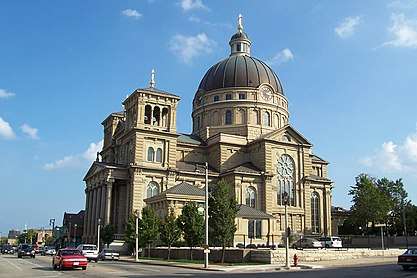
As of 2010, approximately 51.8% of residents in the Milwaukee area said they regularly attended religious services. 24.6% of the Milwaukee area population identified as Catholic, 10.8% as Lutheran, 1.6% as Methodist, and 0.6% as Jewish.[66]
The Roman Catholic Archdiocese of Milwaukee and the Episcopal Diocese of Milwaukee are headquartered in Milwaukee. The School Sisters of the Third Order of St Francis have their mother house in Milwaukee, and several other religious orders have a significant presence in the area, including the Jesuits and Franciscans. Milwaukee, where Father Josef Kentenich was exiled for 14 years from 1952 to 1965, is also the center for the Schoenstatt Movement in the United States. St. Joan of Arc Chapel, the oldest church in Milwaukee, is on the Marquette University campus. St. Josaphat Basilica was the first church to be given the Basilica honor in Wisconsin and the third in the United States. Holy Hill National Shrine of Mary, Help of Christians, northwest of Milwaukee, in Hubertus, Wisconsin, was also made a Basilica in 2006.
Milwaukee is home for several Lutheran synods, including the Greater Milwaukee Synod of the Evangelical Lutheran Church in America; the Lutheran Church–Missouri Synod (LCMS), which operates Concordia University Wisconsin in Mequon and Milwaukee Lutheran High School, the nation's oldest Lutheran high school; and the Wisconsin Evangelical Lutheran Synod (WELS), which was founded in 1850 in Milwaukee.
The St. Sava Serbian Orthodox Cathedral is a landmark of the Serbian community in Milwaukee, located by the American Serb hall.
The Church of Jesus Christ of Latter-day Saints has a presence in the Milwaukee area. The Milwaukee area has two stakes, with fourteen wards and four branches among them. The closest temple is the Chicago Illinois Temple. The area is part of the Wisconsin Milwaukee Mission.[67]
Economy
Early economy
Milwaukee's founding fathers had a vision for the city: they knew it was perfectly situated as a port city, a center for collecting and distributing produce. Many of the new immigrants who were pouring into the new state of Wisconsin during the middle of the 19th century were wheat farmers. By 1860, Wisconsin was the second ranked wheat-growing state in the country and Milwaukee shipped more wheat than any place in the world. Railroads were needed to transport all this grain from the wheat fields of Wisconsin to Milwaukee's harbor. Improvements in railways at the time made this possible.
There was intense competition for markets with Chicago, and to a lesser degree, with Racine and Kenosha. Eventually Chicago won out due to its superior financial and transposition status, as well as being a hub on major railroad lines throughout the United States. Milwaukee did solidify its place as the commercial capital of Wisconsin and an important market in the Midwest.[69]
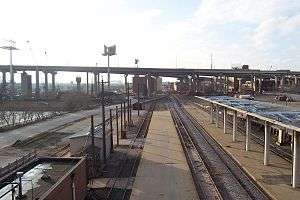
Because of its easy access to Lake Michigan and other waterways, Milwaukee's Menomonee Valley has historically been home to manufacturing, stockyards, rendering plants, shipping, and other heavy industry.
Reshaping of the valley began with the railroads built by city co-founder Byron Kilbourn to bring product from Wisconsin's farm interior to the port. By 1862 Milwaukee was the largest shipper of wheat on the planet, and related industry developed. Grain elevators were built and, due to Milwaukee's dominant German immigrant population, breweries sprang up around the processing of barley and hops. A number of tanneries were constructed, of which the Pfister & Vogel tannery grew to become the largest in America.
In 1843 George Burnham and his brother Jonathan opened a brickyard near 16th Street. When a durable and distinct cream-colored brick came out of the clay beds, other brickyards sprang up to take advantage of this resource. Because many of the city's buildings were built using this material it earned the nickname "Cream City", and consequently the brick was called Cream City brick. By 1881 the Burnham brickyard, which employed 200 men and peaked at 15 million bricks a year, was the largest in the world.
Flour mills, packing plants, breweries, railways and tanneries further industrialized the valley. With the marshlands drained and the Kinnickinnic and Milwaukee Rivers dredged, attention turned to the valley.
Along with the processing industries, bulk commodity storage and machining and manufacturing entered the scene. The valley was home to the Milwaukee Road, Falk Corporation, Cutler-Hammer, Harnischfeger Corporation, Chain Belt Company, Nordberg Manufacturing Company and other industry giants.
Early in the 20th century, Milwaukee was home to several pioneer brass era automobile makers, including Ogren (1919–1922).[70]
Brewing
Milwaukee became synonymous with Germans and beer beginning in the 1840s. The Germans had long enjoyed beer and set up breweries when they arrived in Milwaukee. By 1856, there were more than two dozen breweries in Milwaukee, most of them owned and operated by Germans. Besides making beer for the rest of the nation, Milwaukeeans enjoyed consuming the various beers produced in the city's breweries. As early as 1843, pioneer historian James Buck recorded 138 taverns in Milwaukee, an average of one per forty residents. Today, beer halls and taverns are abundant in the city, but only one of the major breweries—Miller—remains in Milwaukee.[69]
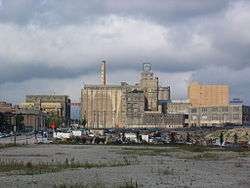
Milwaukee was once the home to four of the world's largest beer breweries (Schlitz, Blatz, Pabst, and Miller), and was the number one beer producing city in the world for many years. As late as 1981, Milwaukee had the greatest brewing capacity in the world.[71] Despite the decline in its position as the world's leading beer producer after the loss of two of those breweries, Miller Brewing Company remains a key employer by employing over 2,200 of the city's workers.[72] Because of Miller's position as the second-largest beer-maker in the U.S., the city remains known as a beer town. The city and surrounding areas are seeing a resurgence in microbreweries, nanobreweries and brewpubs with the craft beer movement.[73]
The historic Milwaukee Brewery in "Miller Valley" at 4000 West State Street, is the oldest functioning major brewery in the United States. In 2008, Coors beer also began to be brewed in Miller Valley. This created additional brewery jobs in Milwaukee, but the company's world headquarters moved from Milwaukee to Chicago.
In addition to Miller and the heavily automated Leinenkugel's brewery in the old Blatz 10th Street plant, other stand-alone breweries in Milwaukee include Milwaukee Brewing Company, a microbrewery in Walker's Point neighborhood; Lakefront Brewery, a microbrewery in Brewers Hill; and Sprecher Brewery, a German brewery that also brews craft sodas. Since 2015, nearly two dozen craft brewing companies have been established in the city.[74][75]
Three beer brewers with Wisconsin operations made the 2009 list of the 50 largest beermakers in the United States, based on beer sales volume. Making the latest big-breweries list from Wisconsin is MillerCoors at No. 2. MillerCoors is a joint venture formed in 2008 by Milwaukee-based Miller Brewing Co. and Golden, Colorado-based Molson Coors Brewing Company. The Minhas Craft Brewery in Monroe, Wisconsin, which brews Huber, Rhinelander and Mountain Crest brands, ranked No. 14 and New Glarus Brewing Company, New Glarus, Wisconsin, whose brands include Spotted Cow, Fat Squirrel and Uff-da, ranked No. 32.[76]
Happy Days and Laverne and Shirley, two sitcoms that aired on ABC in the 1970s and 1980s, were set in Milwaukee, and often used the Milwaukee breweries as a backdrop for the storyline.
Milwaukee's economy today
Milwaukee is the home to the international headquarters of six Fortune 500 companies: Johnson Controls, Northwestern Mutual, Manpower, Rockwell Automation, Harley-Davidson and Joy Global.[77] Other companies based in Milwaukee include Briggs & Stratton, Brady Corporation, Baird (investment bank), Alliance Federated Energy, Sensient Technologies, Marshall & Ilsley (acquired by BMO Harris Bank in 2010),[78] Hal Leonard, Direct Supply, Wisconsin Energy, Rite-Hite, the American Society for Quality, A. O. Smith, Rexnord, Master Lock, Marcus Corporation, REV Group, American Signal Corporation,[79] GE Healthcare Diagnostic Imaging and Clinical Systems and MGIC Investments. The Milwaukee metropolitan area ranks fifth in the United States in terms of the number of Fortune 500 company headquarters as a share of the population. Milwaukee also has a large number of financial service firms, particularly those specializing in mutual funds and transaction processing systems, and a number of publishing and printing companies.
Service and managerial jobs are the fastest-growing segments of the Milwaukee economy, and health care alone makes up 27% of the jobs in the city.[80]
Culture
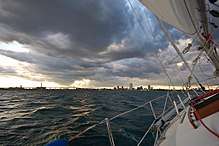
Milwaukee is a popular venue for Lake Michigan sailing, windsurfing, kitesurfing, ethnic dining, and cultural festivals. Often referred to as the City of Festivals, Milwaukee has various cultural events which take place throughout the summer at Henry Maier Festival Park, on the lake. Museums and cultural events, such as Jazz in the Park, occur weekly in downtown parks. A 2011 study by Walk Score ranked Milwaukee 15th most walkable of fifty largest U.S. cities.[81] In 2018, the city was voted "The Coolest City in the Midwest" by Vogue.[82]
Museums
Art
- The Milwaukee Art Museum is perhaps Milwaukee's most visually prominent cultural attraction; especially its $100 million wing designed by Santiago Calatrava in his first American commission.[83] The museum includes a brise soleil, a moving sunscreen that unfolds similarly to the wing of a bird.
- The Grohmann Museum, at Milwaukee School of Engineering contains the world's most comprehensive art collection dedicated to the evolution of human work.[84] It houses the Man at Work collection, which comprises more than 700 paintings and sculptures dating from 1580 to the present. The museum also features a rooftop sculpture garden.
- Haggerty Museum of Art, on the Marquette University campus houses several classical masterpieces and is open to the public.
- The Villa Terrace Decorative Arts Museum is the former home of Lloyd Smith, president of the A.O. Smith corporation, and has a terraced garden, an assortment of Renaissance art, and rotating exhibits.[85]
- Charles Allis Art Museum, in the Tudor-style mansion of Charles Allis, hosts several changing exhibits every year in the building's original antique furnished setting.
Science and natural history
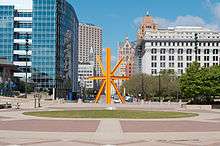
- The Milwaukee Public Museum has been Milwaukee's primary natural history and human history museum for 125 years, with over 150,000 square feet (14,000 m2) of permanent exhibits.[86] Exhibits feature Africa, Europe, the Arctic, Oceania, and South and Middle America, the ancient Western civilizations ("Crossroads of Civilization"), dinosaurs, the tropical rainforest, streets of Old Milwaukee, a European Village, live insects and arthropods ("Bugs Alive!") a Sampson Gorilla replica, the Puelicher Butterfly Wing, hands-on laboratories, and animatronics. The museum also contains an IMAX movie theater/planetarium. Milwaukee Public Museum owns the world's largest dinosaur skull.[87]
- Discovery World, Milwaukee's largest museum dedicated to science, is just south of the Milwaukee Art Museum along the lake front. Visitors are drawn by its high-tech, hand-on exhibits, salt water and freshwater aquariums, as well as touch tanks and digital theaters. A double helix staircase wraps around the 40-foot (12 m) kinetic sculpture of a human genome. The S/V Dennis Sullivan Schooner Ship docked at Discovery World is the world's only re-creation of an 1880s-era three-masted vessel and the first schooner to be built in Milwaukee in over 100 years. It teaches visitors about the Great Lakes and Wisconsin's maritime history.
- Betty Brinn Children's Museum[88] is geared toward children under ten years of age and is filled with hands-on exhibits and interactive programs, offering families a chance to learn together. Voted one of the top ten museums for children by Parents Magazine, it exemplifies the philosophy that constructive play nurtures the mind.
- Mitchell Park Horticultural Conservatory (Mitchell Park Domes or, simply, the Domes) is a conservatory at Mitchell Park. It is owned and operated by the Milwaukee County Park System, and replaced the original Milwaukee Conservatory which stood from 1898 to 1955. The three domes display a large variety of plant and bird life. The conservatory includes the Tropical Dome, the Arid Dome and the Show Dome, which hosts four seasonal (cultural, literary, or historic) shows and one Christmas exhibit held annually in December for visitors to enjoy. The Domes are deteriorating rapidly "and the popular horticultural conservatory will close within a few years unless $30 million is found to do just basic repairs."[89]
Social and cultural history
- Pabst Mansion Built in 1892 by beer tycoon Frederick Pabst, this Flemish Renaissance Mansion was once considered the jewel of Milwaukee's famous avenue of mansions called the "Grand Avenue". Interior rooms have been restored with period furniture, to create an authentic replica of a Victorian Mansion. Nationally recognized as a house museum.
- Milwaukee County Historical Society features Milwaukee during the late 19th century through the mid-20th century. Housed within an architectural landmark, the Milwaukee's Historical Society features a panoramic painting of Milwaukee, firefighting equipment, period replicas of a pharmacy and a bank, and Children's world – an exhibit that includes vintage toys, clothes and school materials. The museum houses a research library, where scenes from the movie Public Enemies were shot.
- Wisconsin Black Historical Society,[90] whose mission is to document and preserve the historical heritage of African descent in Wisconsin, exhibiting collecting and disseminating materials depicting this heritage.
- America's Black Holocaust Museum, founded by lynching survivor James Cameron, featured exhibits which chronicle the injustices suffered throughout history by African Americans in the United States. The museum first closed in July 2008 as a result of financial difficulties.[91] The museum reopened in 2012 as a virtual museum with the original building demolished. As of 2018 a new building housing the museum has opened.[92][93]
- Jewish Museum Milwaukee,[94] is dedicated to preserving and presenting the history of the Jewish people in southeastern Wisconsin and celebrating the continuum of Jewish heritage and culture.
- Mitchell Gallery of Flight, at Milwaukee Mitchell International Airport, Milwaukee's aviation and historical enthusiasts experience the history of Milwaukee Mitchell International Airport with a visit to the Gallery of Flight. Exhibits include General Billy Mitchell; replicas of past and present aircraft including the Lawson Airline, the first commercial airliner; the Graf Zeppelin II, the sistership to the tragically legendary Hindenburg; a 1911 Curtis Pusher, an airplane with the propeller in the rear of the plane; and the present day giant of the sky, the 747. Other exhibits include commercial air memorabilia, early aviation engines and airport beacons.
- Harley-Davidson Museum, opened in 2008, pays tribute to Harley-Davidson motorcycles and is the only museum of its type in the world.
- Chudnow Museum of Yesteryear
Arenas and performing arts
Performing arts groups and venues include:
- Bel Canto Chorus
- First Stage Children's Theater
- Florentine Opera
- Marcus Center for the Performing Arts
- Miller High Life Theatre
- Milwaukee Symphony Orchestra
- Milwaukee Youth Arts Center
- Milwaukee Ballet
- Milwaukee Repertory Theater
- Milwaukee Opera Theatre
- Milwaukee Public Theatre
- Milwaukee Youth Theatre
- Pabst Theater
- Pioneer Drum and Bugle Corps
- Present Music
- The Rave /Eagles Ballroom
- Riverside Theater
- Skylight Music Theatre
- Wisconsin Conservatory of Music
- Turner Hall
- Fiserv Forum
- Miller Park
- UW–Milwaukee Panther Arena
- Marcus Amphitheater on the Henry Maier Festival Park Summerfest Grounds
In 1984 ComedySportz was founded in Milwaukee by native Dick Chudnow and has since become a franchise, with numerous venues throughout the United States and England. In July 2009 the ComedySportz world championship returned to Milwaukee to coincide with its 25th anniversary.
 The Rave/Eagles Ballroom
The Rave/Eagles Ballroom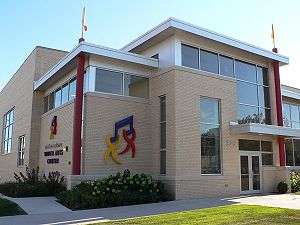
 Turner Hall
Turner Hall
Public art and monuments
Milwaukee has some 75 sculptures to honor the many people and topics reflecting the city's history.[95] Among the more prominent monuments are:
- Friedrich Wilhelm von Steuben
- Tadeusz Kościuszko
- Casimir Pulaski
- Solomon Juneau
- Abraham Lincoln
- George Washington
- Bronze Fonz
- Pope John Paul II
- Martin Luther King Jr.
- The Victorious Charge
- Leif Ericson
- Jacques Marquette
- Goethe-Schiller Monument
- Immigrant Mother
- Letter Carriers' Monument, a memorial to the National Association of Letter Carriers
- Leif Ericson monument
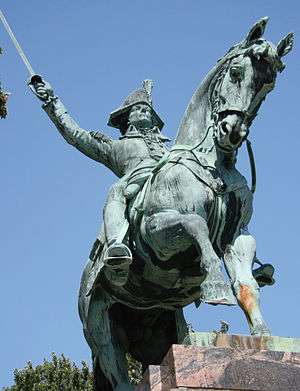 Tadeusz Kościuszko monument in Kosciuszko Park in Historic Lincoln Village.
Tadeusz Kościuszko monument in Kosciuszko Park in Historic Lincoln Village.
Additionally, Milwaukee has a burgeoning mural arts scene. Black Cat Alley is a well-known arts destination in a one-block alleyway in the East Side neighborhood of Milwaukee, recognized for its street art mural installations. It is located behind the historic Oriental Theatre and includes both temporary and semi-permanent installations by a variety of artists and art groups. Another highly visible corridor of street art in Milwaukee is located on the south side in the Walker's Point neighborhood, especially along 5th and 2nd streets.
Festivals
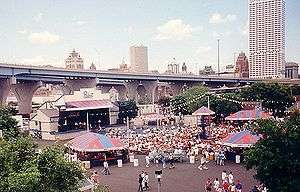
The city hosts an annual lakefront music festival called Summerfest. Listed in the 1999 Guinness Book of World Records as the largest music festival in the world, in 2017 Summerfest attracted 831,769.[96] The adjacent city of West Allis has been the site of the Wisconsin State Fair for over a century.
Milwaukee hosts a variety of primarily ethnically themed festivals throughout the summer. Held generally on the lakefront Summerfest grounds, these festivals span several days (typically Friday plus the weekend) and celebrate Milwaukee's history and diversity. Festivals for the LGBT (PrideFest) and Polish (Polish Fest) communities are typically held in June. Summerfest spans 11 days at the end of June and beginning of July. There are French (Bastille Days), Greek, Italian (Festa Italiana) and German (German Fest) festivals in July. The African, Arab, Irish (Irish Fest), Mexican, and American Indian events wrap it up from August through September.[97] Milwaukee is also home to Trainfest, the largest operating model railroad show in America, in November.
Cuisine
Milwaukee's ethnic cuisines include German, Italian, Russian, Hmong, French, Serbian, Polish, Thai, Japanese, Chinese, Mexican, Indian, Korean, Vietnamese, Turkish, Middle Eastern and Ethiopian.
Famous Chef Julia Child visited Milwaukee and selected Milwaukee native chef Sanford D'Amato to cook for her 80th birthday.[98] D'Amato, trained in New York City, is the executive chef for Milwaukee's five-star restaurant Sanford.[98]
Milwaukee County hosts the Zoo-A La Carte at the Milwaukee County Zoo, and various ethnic festivals like Summerfest, German Fest, and Festa Italiana to celebrate various types of cuisine in summer months.
Music
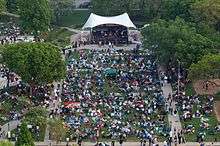
Milwaukee has a long history of musical activity. The first organized musical society, called "Milwaukee Beethoven Society" formed in 1843, three years before the city was incorporated.[99]
The large concentrations of German and other European immigrants contributed to the musical character of the city. Saengerfesten were held regularly.[100]
In the early 20th century, guitarist Les Paul and pianist Liberace were some of the area's most famous musicians. Both Paul, born in Waukesha, and Liberace, born in West Allis, launched their careers in Milwaukee music venues. Paramount Records, primarily a jazz and blues record label, was founded in Grafton, a northern suburb of Milwaukee, in the 1920s and 1930s. Hal Leonard Corporation, founded in 1947 is one of the world's largest music print publishers, and is headquartered in Milwaukee.[101] More recently, Milwaukee has a history of rock, hip hop, jazz, soul, blues, punk, ska, industrial music, electronica, world music, and pop music bands.
Milwaukee's most famous music venue is Summerfest. Founded in 1968, Summerfest features 700-800 live musical acts across 12 stages during 11 days over a 12-day period beginning in late June; while the dates adjust each year, Summerfest always includes July 4. On the Summerfest grounds, the largest venue is the American Family Insurance Amphitheater with a 23,000 person capacity. Adjacent is the BMO Harris Pavilion, which has a capacity of roughly 10,000. The BMO Harris Pavilion also hosts numerous concerts and events outside of Summerfest; other stages are also used during the numerous other festivals held on the grounds.
Venues such as Pabst Theater, Marcus Center for Performing Arts, the Helene Zelazo Center for the Performing Arts, Marcus Amphitheater (Summerfest Grounds), Riverside Theater, the Northern Lights Theater, and The Rave frequently bring internationally known acts to Milwaukee. 'Jazz in the Park', a weekly jazz show held at downtown Cathedral Square Park, has become a summer tradition; free, public performances with a picnic environment.[102] Nearby Pere Marquette Park hosts "River Rhythms" on Wednesday nights.
The Milwaukee area is known for producing national talents such as Steve Miller (rock), Wladziu Valentino Liberace (piano), Al Jarreau (jazz), Eric Benet (neo-soul), Speech (hip hop), Daryl Stuermer (rock), Streetz-n-Young Deuces (Hip-Hop), BoDeans (rock), Les Paul (jazz), the Violent Femmes (alternative), Coo Coo Cal (rap), Die Kreuzen (punk), Andy Hurley of Fall Out Boy (punk), Eyes To The Sky (hardcore), Rico Love (R&B), Andrew 'The Butcher' Mrotek of The Academy Is... (alt-rock), Showoff (pop-punk), The Promise Ring (indie), Lights Out Asia (post-rock), the Gufs (alt rock), Brief Candles (rock), IshDARR (rap) and Decibully (indie).
Municipal wireless
Through its Milwaukee Wireless Initiative, the city has contracted with Midwest Fiber Networks to invest US$20 million in setting up a municipal wireless network city-wide. Under the plan, the city will designate numerous government and public service websites for free access, and city residents will be able to access unlimited content for a monthly fee. Full wireless coverage was expected by March 2008,[103] but delays have been reported.[104]
The city had previously established free wireless networks in two downtown city parks: Cathedral Square; and Pere Marquette Park.[105][106][107]
Sports
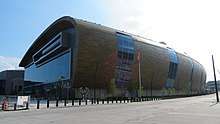
Currently, Milwaukee's sports teams include:
| Club | Sport | Founded | Current League | Stadium |
|---|---|---|---|---|
| Milwaukee Bavarians | Soccer | 1929[108] | United Premier Soccer League | Heartland Value Fund Stadium |
| Milwaukee Bucks | Basketball | 1968 | Eastern and Central (NBA) | Fiserv Forum |
| Milwaukee Brewers | Baseball | 1970 | National League (MLB) | Miller Park |
| Marquette Golden Eagles | Basketball | 1916 | Big East Conference (NCAA) | Fiserv Forum |
| Milwaukee Admirals | Hockey | 1970 | American Hockey League | UW–Milwaukee Panther Arena |
| Milwaukee Wave | Indoor soccer | 1984 | Major Arena Soccer League | UW–Milwaukee Panther Arena |
| Brewcity Bruisers | Roller Derby | 2006 | WFTDA | UW–Milwaukee Panther Arena |
| Milwaukee Milkmen | Baseball | 2018 | American Association of Independent Professional Baseball | Franklin Field |
The city currently has no NFL or NHL team, two of the Major professional sports leagues in the United States and Canada. For NFL, Milwaukee was supported by the Milwaukee Badgers in the 1920s, but Milwaukee is considered a home market for the Green Bay Packers.[109] The team split its home schedule between Green Bay and Milwaukee from 1933 to 1994, with the majority of the Milwaukee games being played at County Stadium.[110] Former season ticketholders for the Milwaukee games continue to receive preference for one pre-season and the second and fifth regular season games at Lambeau Field each season, along with playoff games through a lottery under the "Gold Package" plan.[111] The Packers' longtime flagship station is Milwaukee-based WTMJ AM 620.[112]
Milwaukee has a rich history of involvement in professional and nonprofessional sports, since the 19th century. Abraham Lincoln watched cricket in Milwaukee in 1849 when he attended a game between Chicago and Milwaukee. In 1854, the Milwaukee Cricket Club had 150 members.[113]
Milwaukee was also the host city of the International Cycling Classic, which included the men's and women's Superweek Pro Tour races, featuring professional and amateur cyclists and teams from across the U.S. and more than 20 foreign countries.
Parks and recreation

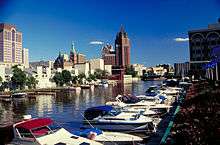
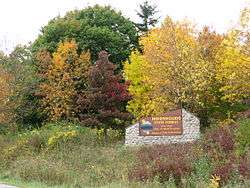
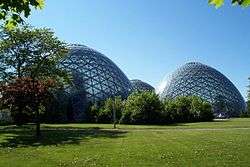
Milwaukee County is known for its well-developed Parks of Milwaukee park system.[114] The "Grand Necklace of Parks", designed by Frederick Law Olmsted, designer of New York's Central Park, includes Lake Park, River Park (now Riverside Park), and West Park (now Washington Park). Milwaukee County Parks offer facilities for sunbathing, picnics, grilling, disc golf, and ice skating.[115] Milwaukee has over 140 parks with over 15,000 acres (6,100 ha) of parks and parkways. In its 2013 ParkScore ranking, The Trust for Public Land, a national land conservation organization, reported Milwaukee had the 19th best park system among the 50 most populous U.S. cities.[116]
Parks and nature centers
The Monarch Trail, on the Milwaukee County Grounds in Wauwatosa, is a 1.25-mile (2 km) trail that highlights the fall migration of the monarch butterflies.[117]
During the summer months, Cathedral Park in Downtown Milwaukee hosts "Jazz in the Park" on Thursday nights.[118] Nearby Pere Marquette Park hosts "River Rhythms" on Wednesday nights.
Milwaukee County public markets
Milwaukee Public Market, in the Third Ward neighborhood, is an indoor market that sells produce, seafood, meats, cheeses, vegetables, candies, and flowers from local businesses.
Milwaukee County Farmers Markets, held in season, sell fresh produce, meats, cheeses, jams, jellies, preserves and syrups, and plants. Farmers markets also feature artists and craftspeople. Locations include: Aur Farmers Market, Brown Deer Farmers Market, Cudahy Farmers Market, East Town Farm Market, Enderis Park Farmers Market, Fondy Farmers Market, Mitchell Street Market, Riverwest Gardeners' Market, Silver Spring Farmers Market, South Milwaukee Farmers Market, South Shore Farmers Market, Uptown Farmers Market, Wauwatosa Farmers Market, West Allis Farmers Market, and Westown Market on the Park.
Government and politics
Milwaukee has a mayor-council form of government. With the election of Mayor John O. Norquist in 1988, the city adopted a cabinet form of government with the mayor appointing those department heads not otherwise elected or appointed—notably the Fire and Police Chiefs. While this gave the mayor greater control of the day-to-day operations of the city, the Common Council retains almost complete control over the city's finances and the mayor, with the exception of his proposed annual budget, cannot directly introduce legislation. The Common Council consists of 15 members, one from each district in the city. Milwaukee has a history of giving long tenures to its mayors; from Frank Zeidler to current mayor Tom Barrett, the city has had only four mayors in the last 60 years. When 28-year incumbent Henry Maier retired in 1988, he held the record for longest term of service for a city of Milwaukee's size.
In addition to the election of a Mayor and Common Council on the city level, Milwaukee residents elect county representatives to the Milwaukee County Board of Supervisors, as well as a Milwaukee County Executive. The current County Executive is Chris Abele.
Milwaukee has been a Democratic stronghold for more than a century at the federal level.[119] At the local level, Socialists frequently won the mayorship and (for briefer periods) other city and county offices during much of the first sixty years of the 20th century. The city is split between seven state Senate districts, each of which is composed of three Assembly districts. All but four state legislators representing the city are Democrats; the four Republicans—two in the State Assembly and two in the State Senate—represent outer portions of the city that are part of districts dominated by heavily Republican suburban counties. In 2008, Barack Obama won Milwaukee with 77% of the vote.[120] Tim Carpenter (D), Lena Taylor (D), Robyn Vining (R), LaTonya Johnson (D), Chris Larson (D), Alberta Darling (R), and Mary Lazich (R) represent Milwaukee in the Wisconsin State Senate, and Daniel Riemer (D), JoCasta Zamarripa (D), Marisabel Cabrera (D), David Bowen (D), Jason Fields (D), LeKesiha Meyers (D), Rob Hutton (R), Dale P. Kooyenga (R), Kalan Haywood II (D), David Crowley (D), Evan Goyke (D), Jonathan Brostoff (D), Christine Sinicki (D), Janel Brandtjen (R), and Mike Kuglitsch (R) represent Milwaukee in the Wisconsin State Assembly.
Milwaukee makes up the overwhelming majority of Wisconsin's 4th congressional district. The district is heavily Democratic. The Democratic primary for the seat is considered more important than the general election.[121] The district is currently represented by Democrat Gwen Moore. A Republican has not represented a significant portion of Milwaukee in Congress since Charles J. Kersten lost his seat in the 5th district in 1954 to Democrat Henry S. Reuss. The small portions of the city extending into Waukesha and Washington counties are part of the 5th District, represented by Republican Jim Sensenbrenner.
A Mexican Consulate is also located in Milwaukee that serves a total of 65 counties in Wisconsin and the Upper Peninsula of Michigan.[122]
Crime
For several years, Milwaukee ranked among the ten most dangerous large cities in the United States.[123][124] Despite its improvement since then, Milwaukee still fares worse when comparing specific crime types to the national average (e.g., homicide, rape, robbery, aggravated assault)[125][126] The Milwaukee Police Department's Gang Unit was reactivated in 2004 after Nannette Hegerty was sworn in as chief. In 2006, 4,000 charges were brought against suspects through Milwaukee's Gang Unit.[127] In 2013 there were 105 murders in Milwaukee and 87 homicides the following year.[128] In 2015, 146 people were killed in the city.[129] In 2018, Milwaukee was ranked the eighth most dangerous city in the US.[130]
Police Chief Alfonso Morales was demoted to captain over the department’s use of tear gas during protests against police brutality in June and July 2020.[131]
Poverty
As of 2016, Milwaukee currently ranks as the second poorest U.S. city with over 500,000 residents, falling behind only Detroit.[132] In 2013, a Point-In-Time survey estimated 1,500 people were homeless on Milwaukee's streets each night.[133] The city's homeless and poor are aided by several local nonprofits, including the Milwaukee Rescue Mission.
Election results
| Year | Democratic | Republican | Third Parties | Other | Totals |
|---|---|---|---|---|---|
| 2016[134] | 80.6% 188,700 | 19.4% 45,422 | |||
| 1920 | 22,508 | 63,525 | 38,399 | 423 | 124,855 |
| 1916 | 30,463 | 25,549 | 15,368 | 344 | 69,724 |
| 1912 | 24,501 | 15,092 | 17,708 | 5,638 | 62,939 |
| 1908 | 22,812 | 24,432 | 16,124 | 1,065 | 63,433 |
| 1904 | 16,558 | 27,049 | 17,078 | 873 | 61,558 |
| 1900 | 23,109 | 29,616 | 4,602 | 822 | 58,149 |
| 1896 | 23,887 | 30,109 | 634 | 441 | 55,071 |
NOTE: Third party totals from 1896-1920 are for the Socialist Candidate.
Education
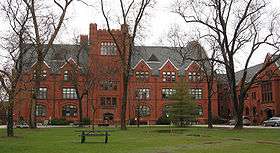
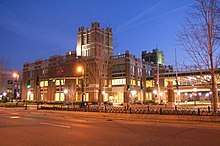
Primary and secondary education
Milwaukee Public Schools (MPS) is the largest school district in Wisconsin and thirty third in the nation. As of 2007, it had an enrollment of 89,912 students[135] and as of 2006 employed 11,100 full-time and substitute teachers in 323 schools. Milwaukee Public Schools operate as magnet schools, with individualized specialty areas for interests in academics or the arts. Washington High School, Riverside University High School, Rufus King High School, Ronald Wilson Reagan College Preparatory High School, Samuel Morse Middle School for the Gifted and Talented, Golda Meir School, Milwaukee High School of the Arts, and Lynde & Harry Bradley Technology and Trade School are some of the magnet schools in Milwaukee. In 2007, 17 MPS high schools appeared on a national list of "dropout factories" – schools where fewer than 60% of freshmen graduate on time.[136] Milwaukee is also home to over two dozen private or parochial high schools and many private and parochial middle and elementary schools.
Of persons in Milwaukee aged 25 and above, 86.9% have a high school diploma, and 29.7% have a bachelor's degree or higher. (2012)[137]
Higher education
Milwaukee area universities and colleges:
- Alverno College
- The Art Institute of Wisconsin
- Bryant and Stratton
- Cardinal Stritch University
- Concordia University Wisconsin
- Herzing University
- Marquette University
- Medical College of Wisconsin (Wauwatosa)
- Milwaukee Area Technical College
- Milwaukee Institute of Art and Design
- Milwaukee School of Engineering
- Mount Mary University
- National-Louis University
- University of Wisconsin–Milwaukee
- Wisconsin Institute for Torah Study
- Wisconsin Lutheran College
Media
Milwaukee's daily newspaper is the Milwaukee Journal Sentinel which was formed when the morning paper the Milwaukee Sentinel merged with the afternoon paper Milwaukee Journal. The city has two free distribution alternative publications, Shepherd Express and Wisconsin Gazette. Other local newspapers, city guides and magazines with large distributions include M Magazine, Milwaukee Magazine, The Bay View Compass, Riverwest Currents, The Milwaukee Courier and Milwaukee Community Journal. OnMilwaukee.com is an online magazine providing news and events. The UWM Post is the independent, student-run weekly at the University of Wisconsin–Milwaukee.
Milwaukee's major network television affiliates are WTMJ 4 (NBC), WITI 6 (Fox), WISN 12 (ABC), WVTV 18 (CW), WVTV-DT2 24 (MyNetworkTV), and WDJT 58 (CBS). Spanish-language programming is on WTSJ 38 (Azteca America) and WYTU-LD 63 (Telemundo). Milwaukee's public broadcasting stations are WMVS 10 and WMVT 36.
Other television stations in the Milwaukee market include WMKE-CD 7 (Quest), WVCY 30 (FN), WBME-CD 41 (Me-TV), WMLW-TV 49 (Independent), WWRS 52 (TBN), Sportsman Channel, and WPXE 55 (ION)
There are numerous radio stations throughout Milwaukee and the surrounding area.
There are two cable PEG channels in Milwaukee: channels 13 and 25.
Until 2015, Journal Communications (a NYSE-traded corporation) published the Journal Sentinel and well over a dozen local weekly newspapers in the metropolitan area. At that time, Journal was split into the Journal Media Group for publishing, while the television and radio stations went to the E. W. Scripps Company (Journal founded WTMJ-TV, along with WTMJ and WKTI). As a result, it was criticized for having a near-monopoly in local news coverage.[138][139] Journal Media Group merged with Gannett in 2017, while Scripps sold the radio stations in 2018 to Good Karma Brands, effectively splitting off the monopoly completely.
Infrastructure
Health care
Milwaukee's health care industry includes several health systems. The Milwaukee Regional Medical Complex, between 8700 and 9200 West Wisconsin Avenue, is on the Milwaukee County grounds. This area includes the Children's Hospital of Wisconsin, Froedtert Hospital, BloodCenter of Wisconsin, the Ronald McDonald House, Curative Rehabilitation, and the Medical College of Wisconsin. Aurora Health Care includes St. Luke's Medical Center, Aurora Sinai Medical Center, Aurora West Allis Medical Center, and St. Luke's SouthShore. Wheaton Franciscan Healthcare includes St. Joseph's Hospital, St. Francis Hospital, The Wisconsin Heart Hospital, Elmbrook Memorial (Brookfield), and other outpatient clinics in the Milwaukee area. Columbia St. Mary's Hospital is on Milwaukee's lakeshore and has established affiliations with Froedtert Hospital and the Medical College of Wisconsin. The Medical College of Wisconsin is one of two medical schools in Wisconsin and the only one in Milwaukee.
Other health care non-profit organizations in Milwaukee include national headquarters of the American Academy of Allergy, Asthma, and Immunology and the Endometriosis Association.
Transportation
Airports
Milwaukee has two airports: Milwaukee Mitchell International Airport (KMKE) on the southern edge of the city, which handles the region's commercial traffic, and Lawrence J. Timmerman Airport (KMWC), known locally as Timmerman Field, on the northwest side along Appleton Avenue.
Mitchell is served by twelve airlines,[140] which offer roughly 240 daily departures and 245 daily arrivals. Approximately 90 cities are served nonstop or direct from Mitchell International. It is the largest airport in Wisconsin and the 34th largest in the nation.[141] The airport terminal is open 24 hours a day. Since 2005, Mitchell International Airport has been connected by the Amtrak Hiawatha train service, which provides airport access via train to Chicago and downtown Milwaukee. Southwest, Frontier Airlines, American Airlines, United Airlines, Air Canada, and Delta Air Lines are among the carriers using Milwaukee's Mitchell International Airport gates.[140] In July 2015, it served 610,271 passengers.[142]
Intercity rail and bus
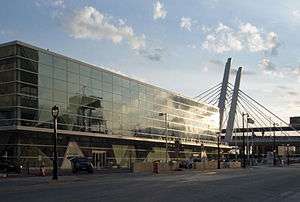
Milwaukee's Amtrak station was renovated in 2007 to create Milwaukee Intermodal Station near downtown Milwaukee and the Third Ward to provide Amtrak riders access to Greyhound Lines, Jefferson Lines, 24 hour Megabus service, and other intercity bus operators. Milwaukee is served by Amtrak's Hiawatha Service passenger train up to seven times daily between Milwaukee Intermodal Station and Chicago Union Station, including a stop at the Milwaukee Airport Railroad Station, Sturtevant, Wisconsin, and Glenview, Illinois. Amtrak's Empire Builder stops at Milwaukee Intermodal Station and connects to Chicago and the Pacific Northwest, with several stops along the way.
In 2010, $800 million in federal funds were allocated to the creation of high-speed rail links from Milwaukee to Chicago and Madison,[143] but the funds were rejected by the then newly elected Governor of Wisconsin Scott Walker.[144] and the trains were sold to Michigan. In 2016, WisDOT and IDOT conducted studies to upgrade service on the Amtrak Hiawatha line from seven to ten times daily between downtown Milwaukee and downtown Chicago.[145][146]
Transit
- Bus: The Milwaukee County Transit System provides bus services within Milwaukee County. The Badger Bus station in downtown Milwaukee provides bus service between Milwaukee and Madison.
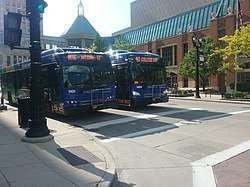 Two MCTS buses
Two MCTS buses - Streetcar: A modern streetcar system, The Hop, connects Milwaukee Intermodal Station, downtown Milwaukee, and Ogden Avenue on the city's Lower East Side. The line began service November 2, 2018 with future plans for extensions the lakefront and surrounding neighborhoods.[147][148]
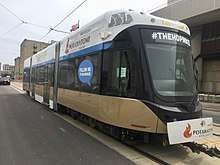 A Milwaukee Streetcar
A Milwaukee Streetcar - Commuter rail: Milwaukee currently has no commuter rail system. Previous efforts to develop one proposed a 0.5% sales tax in Milwaukee, Racine and Kenosha counties to fund an expansion of Metra's Union Pacific / North Line from Kenosha to Milwaukee Intermodal Station. However, Wisconsin repealed the legislation authorizing such efforts in June 2011, and the project is now defunct.[149]
Highways
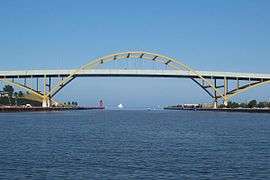
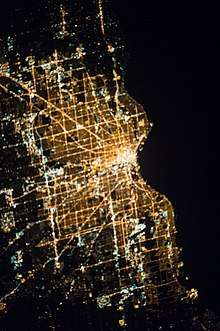
Three of Wisconsin's Interstate highways intersect in Milwaukee. Interstate 94 (I-94) comes north from Chicago to enter Milwaukee and continues west to Madison. The stretch of I-94 from Seven Mile Rd. to the Marquette Interchange in Downtown Milwaukee is known as the North-South Freeway. I-94 from Downtown Milwaukee west to Wisconsin 16 is known as the East-West Freeway.
I-43 enters Milwaukee from Beloit in the southwest and continues north along Lake Michigan to Green Bay via Sheboygan and Manitowoc. I-43 southwest of I-41/I-894/US 41/US 45 Hale Interchange is known as the Rock Freeway. I-43 is cosigned with I-894 East and I-41/US 41 South to I-94 is known as the Airport Freeway. At I-94, I-43 follows I-94 to the Marquette Interchange. I-43 continues north known as the North-South Freeway to Wisconsin Highway 57 near Port Washington.
Approved in 2015, Interstate 41 follows I-94 north from the state line before turning west at the Mitchell Interchange to the Hale Interchange and then north to Green Bay via Fond du Lac, Oshkosh and Appleton. I-41/US 41/US 45 from the Hale Interchange to Wisconsin Hwy 145 is known as the Zoo Freeway.
Milwaukee has two auxiliary Interstate Highways, I-894 and I-794. I-894 bypasses Downtown Milwaukee on the west and south sides of the city from the Zoo Interchange to the Mitchell Interchange. I-894 is part of the Zoo Freeway and the Airport Freeway. I-794 extends east from the Marquette Interchange to Lake Michigan before turning south over the Hoan Bridge toward Milwaukee Mitchell International Airport, turning into Highway 794 along the way. This is known as the Lake Freeway.
Milwaukee is also served by three US Highways. U.S. Highway 18 (US 18) provides a link from Downtown to points west heading to Waukesha along Wells St, 17th/16th Sts, Highland Ave, 35th St, Wisconsin Ave and Blue Mound Rd. US 41 and US 45 both provide north–south freeway transportation on the western side of the city. The freeway system in Milwaukee carries roughly 25% of all travel in Wisconsin.[150]
Milwaukee County is also served by several Wisconsin highways. These include the following:
- Hwy. 24 (Forest Home Ave.)
- Hwy. 32 (Chicago Ave., College Ave., S. Lake Dr., Howard Ave., Kinnickinnic Ave., 1st St., Pittsburgh Ave., Milwaukee St., State St., Prospect Ave. NB/Farwell Ave. SB, Bradford Ave., N. Lake Dr., Brown Deer Rd.)
- Hwy. 36 (Loomis Rd.)
- Hwy. 38 (Howell Ave., Chase Ave., 6th St.)
- Hwy. 57 (27th St., Highland Ave., 20th St., Capitol Dr., Green Bay Ave.)
- Hwy. 59 (Greenfield Ave./National Ave.)
- Hwy. 100 (Ryan Rd., Lovers Lane Rd., 108th St., Mayfair Rd., Brown Deer Rd.)
- Hwy. 119 (Airport Spur)
- Hwy. 145 (Fond du Lac Ave, Fond du Lac Freeway)
- Hwy. 175 (Appleton Ave., Lisbon Ave., Stadium Freeway)
- Hwy 181 (84th St., Glenview Ave., Wauwatosa Ave., 76th St.)
- Hwy. 190 (Capitol Dr.)
- Hwy. 241 (27th St.)
- Hwy. 794 (Lake Pkwy.)
In 2010, the Milwaukee area was ranked the 4th best city for commuters by Forbes.[151]
Water
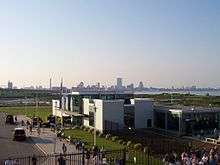
Milwaukee's main port, Port of Milwaukee, handled 2.4 million metric tons of cargo through its municipal port in 2014.[152] Steel and salt are handled at the port.
Milwaukee connects with Muskegon, Michigan through the Lake Express high-speed auto and passenger ferry. The Lake Express travels across Lake Michigan from late spring to the fall of each year.
Bicycle
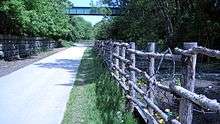
Milwaukee has over 105 miles (169 km) of bicycle lanes and trails, most of which run alongside or near its rivers and Lake Michigan. The Oak Leaf Trail, a multi-use recreational trail, provides bicycle trails throughout the city and county. Still pending are the creation of bicycle lanes along major commuting routes, such as the Hoan Bridge connector between downtown and the suburbs to the south. The city has also identified over 250 miles (400 km) of streets on which bike lanes will fit. It has created a plan labeling 145 miles (233 km) of those as high priority for receiving bike lanes.[153] As part of the city's Bicycle and Pedestrian Task Force's mission to "make Milwaukee more bicycle and pedestrian friendly", over 700 bike racks have been installed throughout the city.[154] The Bicycle Federation of Wisconsin[155] holds an annual Bike to Work Week. The event, held in May each year, has frequently featured a commuter race between a car, a bus, and a bike; and also a morning ride into work with the mayor. In 2006, Milwaukee obtained bronze-level status from the League of American Bicyclists,[156] a rarity for a city its size.[157]
In 2009, the Milwaukee County Transit System began installing bicycle racks to the front of county buses.[158] This "green" effort was part of a settlement of an asbestos lawsuit leveled by the state at the county in 2006.[159] The lawsuit cites the release of asbestos into the environment when the Courthouse Annex was demolished.[160]
In August 2014, Milwaukee debuted a bicycle sharing system called Bublr Bikes, which is a partnership between the City of Milwaukee and a local non-profit Midwest Bike Share (dba Bublr Bikes).[161][162] As of September 2016, the system operates 39 stations throughout downtown, the East Side, and the UW-Milwaukee campus area and near downtown neighborhoods. The City of Milwaukee installed another ten Bublr Bikes stations in October 2016, and the adjacent suburb of Wauwatosa installed eight stations in September 2016, which will bring the system size to 58 stations by the end of 2016. More stations are scheduled for installation in the Village of Shorewood and the City of West Allis in 2017. Future system expansion in the City of Milwaukee is also expected as the City was awarded a second federal Congestion Mitigation/Air Quality (CMAQ) program grant ($1.9 million) to add more stations starting in 2018.[163]
Walkability
A 2015 study by Walk Score ranked Milwaukee as the 15th most walkable out of the 50 largest U.S. cities.[164] As a whole, the city has a score of 62 out of 100. However, several of the more densely populated neighborhoods have much higher scores: Juneautown has a score of 95; the Lower East Side has a score of 91; Yankee Hill scored 91; and the Marquette and Murray Hill neighborhoods both scored 89 each.[165] Those ratings range from "A Walker's Paradise" to "Very Walkable."
Modal characteristics
According to the 2016 American Community Survey, 71% of working city of Milwaukee residents commuted by driving alone, 10.4% carpooled, 8.2% used public transportation, and 4.9% walked. About 2% used all other forms of transportation, including taxicab, motorcycle, and bicycle. About 3.4% of working city of Milwaukee residents worked at home.[166] In 2015, 17.9% of city of Milwaukee households were without a car, which increased to 18.7% in 2016. The national average was 8.7 percent in 2016. Milwaukee averaged 1.3 cars per household in 2016, compared to a national average of 1.8 per household.[167]
City development
On February 10, 2015, a streetcar connecting the Milwaukee Intermodal Station with the city's lower east side was approved by the Common Council, bringing if not to a halt then at least to a pause, decades of sometimes acrimonious debate. On a 9–6 vote, the council approved a measure that established the project's $124 million capital budget, its estimated $3.2 million operating and maintenance budget and its 2.5-mile (4.0 km) route, which includes a lakefront spur connecting the line to the proposed $122 million, 44-story Couture. Construction on the Milwaukee Streetcar began March 2017, with initial operation by mid-2018.[148][168] The Lakefront service is expected to start operation by 2019.[148]
Northwestern Mutual Tower and Commons stands 550 feet (170 m) tall and has 32 stories, making it the second tallest building in Milwaukee.[169][170]
Fiserv Forum, a new multipurpose arena located at 1111 Vel R. Phillips Avenue, has been built to accommodate the Milwaukee Bucks and Marquette Golden Eagles. Construction on the $524 million project began in November 2015 and opened to the public on August 26, 2018.[171] The arena is intended to be the focal point of a "live block" zone that includes public space surrounded by both commercial and residential developments. The arena has a transparent facade and a curved roof and side that is meant to evoke the water forms of nearby Lake Michigan and the Milwaukee River.[172]
Notable people
Sister cities
As of 2018, Milwaukee has eight sister cities and one friendship city around the world:[173]
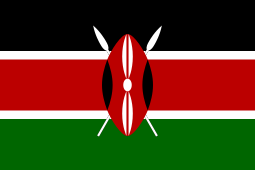




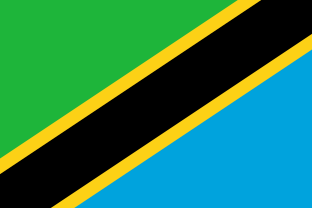


Friendship cities

Officials from Milwaukee and Ningbo have signed an agreement to promote business and cultural ties between the two cities and their respective nations.[175]
See also
- 1947 Wisconsin earthquake
- Excalibur (automobile)
- Flag of Milwaukee, Wisconsin
- Great Lakes Megalopolis
- List of tallest buildings in Milwaukee
- Milwaukee Flood of 2010
- National Register of Historic Places listings in Milwaukee, Wisconsin
- Neighborhoods of Milwaukee
- Parks of Milwaukee
- Seal of Milwaukee, Wisconsin
- Third Coast
- Candy Raisins
- Milwaukee Fire Department
Notes
- Mean monthly maxima and minima (i.e. the expected highest and lowest temperature readings at any point during the year or given month) calculated based on data at said location from 1981 to 2010.
- Records kept January 1871 to February 1941 at the Weather Bureau Office and at General Mitchell Int'l since March 1941. For more information, see Threadex
References
- "2019 U.S. Gazetteer Files". United States Census Bureau. Retrieved August 7, 2020.
- "Population and Housing Unit Estimates". Retrieved May 21, 2020.
- "U.S. Census website". United States Census Bureau. Retrieved January 31, 2008.
- "US Board on Geographic Names". United States Geological Survey. October 25, 2007. Retrieved January 31, 2008.
- "27 Things People From Milwaukee Have To Explain To Out-Of-Towners". Movato.com.
- Bureau, U.S. Census. "U.S. Census website". United States Census Bureau. Retrieved December 11, 2016.
- Bureau, US Census. "Population Change for Metropolitan and Micropolitan Statistical Areas". Census.gov.
- "Extraordinary building boom is reshaping Milwaukee's skyline". Milwaukee Journal Sentinel. Retrieved March 21, 2017.
- Bruce, William George (1936). A Short History of Milwaukee. Milwaukee, Wisconsin: The Bruce Publishing Company. p. 15. LCCN 36010193.
- "Ojibwe Dictionary". Freelang. Retrieved March 25, 2007.
- Hoffman, Mike. "Menominee Place Names in Wisconsin". The Menominee Clans Story. Retrieved October 5, 2018.
- White, Richard (1991). The Middle Ground. New York: Cambridge University Press. p. 146. ISBN 9781139495684.
- Fowler, William (2005). Empires at War. New York: Walker & Company. p. 68. ISBN 9780802719355.
- White, Richard (1991). The Middle Ground. New York: Cambridge University Press. p. 400. ISBN 9781139495684.
- Keating, Ann (2012). Rising Up from Indian Country. Chicago: University of Chicago Press. p. 137.
- St-Pierre, T. Histoire des Canadiens du Michigan et du comté d'essex, Ontario. Cahiers du septentrion, vol. 17. Sillery, Québec: Septentrion. 2000; 1895.
- Bruce, William George (1936). A Short History of Milwaukee. Milwaukee, Wisconsin: The Bruce Publishing Company. pp. 15–16. LCCN 36010193.
- "Bridges | Encyclopedia of Milwaukee". emke.uwm.edu. Retrieved October 3, 2018.
-

- City of Milwaukee. "City of Milwaukee Incorporated, page 164, 1846; page 314, 1851" (PDF). Office of the Secretary of State of Wisconsin. Archived from the original (PDF) on June 5, 2007. Retrieved April 8, 2007.
- Bungert, Heike, Cora Lee Kluge and Robert C. Ostergren. Wisconsin German Land and Life. Madison: Max Kade Institute for German-American Studies, 2006.
- Conzen, Kathleen Neils. Immigrant Milwaukee, 1836–1860. Cambridge, Massachusetts and London, England: Harvard University Press, 1976.
- Conzen, Kathleen Neils. "'The German Athens' Milwaukee and the Accommodation of Its Immigrants 1836–1860." PhD diss., vol. 1, University of Wisconsin-Madison, 1972.
- "Milwaukee and Watertown as Seen by Schurz in 1854". The Milwaukee Journal, October 21, 1941. Accessed February 5, 2013.
- Rippley, LaVern J. and Eberhard Reichmann, trans. "The German Americans, An Ethnic Experience." Max Kade German-American Center and Indiana University-Purdue University at Indianapolis. (accessed February 5, 2013).
- "Milwaukee German Immersion School". 5.milwaukee.k12.wi.us. Retrieved April 24, 2015.
- Data Access and Dissemination Systems (DADS). "American FactFinder – Results". Archived from the original on February 12, 2020.
- "Polish Fest celebrates the 100th anniversary of the rebirth of a nation". Milwaukee Journal Sentinel. Retrieved October 3, 2018.
- Muehlhans-Karides, Susan. "Aus dem Egerland, nach Milwaukee". Archived from the original on April 23, 2010. Retrieved April 25, 2009.
- "Milwaukee Neighborhoods: Photos and Maps, 1885-1992". University of Wisconsin–Milwaukee. Retrieved December 5, 2017.
- "Historical Census Statistics On Population Totals By Race, 1790 to 1990, and By Hispanic Origin, 1970 to 1990, For Large Cities And Other Urban Places In The United States". U.S. Census Bureau. Archived from the original on August 12, 2012. Retrieved December 24, 2011.
- Wisconsinhistory.org, additional text.
- Nan Bialek (November 11, 2010). "It's everyday life that keeps local historian fascinated: But the Hollywood- worthy moments aren't bad, either?".
- "Race and Hispanic Origin for Selected Cities and Other Places: Earliest Census to 1990". U.S. Census Bureau. Archived from the original on August 12, 2012.
- Glabere, Michael. "Milwaukee:A Tale of Three Cities" in, From Redlining to Reinvestment: Community Responses to Urban Disinvestment edited by Gregory D. Squires. Philadelphia: Temple University Press, 2011; p. 151 and passim
- "Dozen Distinctive Destinations – Milwaukee". National Trust for Historic Preservation. 2006. Archived from the original on February 22, 2010.
- "US Gazetteer files 2010". United States Census Bureau. Archived from the original on January 12, 2012. Retrieved November 18, 2012.
- "Historical Weather for Milwaukee, Wisconsin". Weatherbase. Retrieved October 2, 2006.
- "Station Name: WI MILWAUKEE MITCHELL AP". National Climatic Data Center. Retrieved April 21, 2014.
- "Normals and Extremes for Milwaukee and Madison". National Weather Service. Retrieved February 23, 2017.
- "NOWData – NOAA Online Weather Data". National Oceanic and Atmospheric Administration. Retrieved October 10, 2018.
- "WMO Climate Normals for MILWAUKEE/GEN. MITCHELL, WI 1961–1990". National Oceanic and Atmospheric Administration. Retrieved July 25, 2020.
- "Milwaukee, Wisconsin, USA - Monthly weather forecast and Climate data". Weather Atlas. Retrieved July 4, 2019.
- "What Climate Change Means for Wisconsin" (PDF). United States Environmental Protection Agency. August 2016.
- Henderson, Alison (April 17, 2020). "Milwaukee Remains Committed to the Paris Climate Agreement". Shepherd Express.
- Who We Are | Milwaukee Water Council Archived September 24, 2014, at the Wayback Machine. Thewatercouncil.com. Retrieved on July 12, 2013.
- Circles of Sustainability Archived July 2, 2017, at the Wayback Machine. The Cities Programme. Retrieved on July 12, 2013.
- 2012 Prize Winners Archived December 11, 2015, at the Wayback Machine. U.S. Water Alliance. Retrieved on July 12, 2013.
- United States Census Bureau. "Census of Population and Housing". Retrieved August 22, 2014.
- "Population Estimates". United States Census Bureau. Retrieved June 8, 2018.
- "Population Estimates". United States Census Bureau. Archived from the original on May 22, 2014. Retrieved August 22, 2014.
- Toosi, Nahal (August 22, 2001). "Census finds more same-sex households". Milwaukee Journal Sentinel. Archived from the original on February 20, 2007. Retrieved November 24, 2006.
- Killian, Erin (June 2002). "Vital Statistics". Milwaukee Magazine. Archived from the original on January 14, 2006. Retrieved November 24, 2006.
- Tom Daykin (July 8, 2010). "Apartment rents rise, industrial vacancies drop, office vacancies increase". Milwaukee Journal Sentinel. Retrieved October 26, 2010.
- "Milwaukee (city) QuickFacts from the US Census Bureau". Quickfacts.census.gov. Archived from the original on February 7, 2014. Retrieved September 10, 2012.
- Data Access and Dissemination Systems (DADS). "American FactFinder – Results". Archived from the original on February 12, 2020.
- "Milwaukee is most segregated city: U.S. Census analysis". Jet magazine. December 16, 2002. Archived from the original on October 13, 2007.
- "Study explodes myth of area's 'hypersegregation'". Archived from the original on July 12, 2006. Retrieved April 1, 2008.CS1 maint: BOT: original-url status unknown (link)
- Frey, William H. (2018). Diversity Explosion: How New Racial Demographics Are Remaking America (Second ed.). Washington, D.C.: Brookings Institution Press. p. 177. ISBN 978-0-8157-2398-1.
- Levine, Marc V. (May 2004). "Citizens and MMFHC Respond to Milwaukee Journal Sentinel Article: Getting the Facts Right on Segregation in Milwaukee" (PDF). Fair Housing Keys. The Metropolitan Milwaukee Fair Housing Council.
- Pawasarat, John (January 2003). "Racial Integration in Urban America: A Block Level Analysis of African American and White Housing Patterns". University of Wisconsin–Milwaukee Employment and Training Institute. Archived from the original on July 24, 2008. Retrieved March 8, 2007.
- Quinn, Lois M. (October 2004). "Assumptions and Limitations of the Census Bureau Methodology Ranking Racial and Ethnic Residential Segregation in Cities and Metro Areas" (PDF). University of Wisconsin–Milwaukee Employment and Training Institute. Archived from the original (PDF) on October 10, 2008. Retrieved March 8, 2007.
- "Why Milwaukee Is the Worst Place to Live for African Americans".
- "Why Is Milwaukee So Bad For Black People?".
- Pabst, Georgia. "Report shows growth in Hmong community". Milwaukee Journal Sentinel, January 6, 2013. Retrieved March 2, 2014.
- "Metro-Area Membership Report: Milwaukee-Waukesha-West Allis, WI CMSA". Association of Religion Data Archives. 2012. Archived from the original on October 16, 2015. Retrieved September 11, 2015.
- "The Church of Jesus Christ of Latter-day Saints Official Website". 2011. Retrieved April 11, 2011.
- https://www.google.com/maps/search/milwaukee+mosque
- "Milwaukee County Historical Society – Milwaukee Timeline 1800s". Milwaukeehistory.net. Archived from the original on June 10, 2010. Retrieved July 2, 2010.
- Clymer, Floyd (1950). Treasury of Early American Automobiles, 1877–1925. New York: Bonanza Books. p. 153.
- Milwaukee Loses 'Beer Capital' Title as Breweries Shut Off Tap
- "Connected to Wisconsin – its people and its economy" (PDF). Miller Brewing Company. February 2005. Archived from the original (PDF) on August 22, 2006.
- "Demand for better beer foments a new brewery boom in Milwaukee". Milwaukee Journal-Sentinel. Retrieved February 9, 2017.
- Noel, Josh. "Late to the craft beer scene, Milwaukee's small brewers are a big hit". chicagotribune.com. Retrieved March 16, 2019.
- Murphy, Dan. "Welcome to Milwaukee's Brewery Boom: 22 New Breweries to Try". milwaukeemag.com. Retrieved March 16, 2019.
- "Three state breweries make largest list – The Business Journal of Milwaukee". Milwaukee.bizjournals.com. April 14, 2009. Retrieved July 2, 2010.
- Judy Newman – Wisconsin State Journal (May 10, 2013). "Ten Wisconsin companies make the Fortune 500 list for 2013". madison.com.
- Marshall & Ilsley's Shotgun Marriage – Deal Journal – WSJ. Blogs.wsj.com (December 20, 2010). Retrieved on 2013-07-12.
- "A.O. Smith". Archived from the original on October 24, 2008. Retrieved March 23, 2008.
- "Milwaukee's 10 largest employers". Archived from the original on October 12, 2007. Retrieved June 9, 2007.CS1 maint: BOT: original-url status unknown (link)
- "2011 City and Neighborhood Rankings". Walk Score. 2011. Retrieved August 28, 2011.
- Pérez, Christina (July 10, 2018). "Why Milwaukee Is the Midwest's Coolest (and Most Underrated) City". Travel. Vogue. Retrieved December 11, 2019.
- "Museum Info: Santiago Calatrava". Milwaukee Art Museum. Retrieved October 16, 2008.
- Peterson's (October 15, 2011). Cool Colleges 101: The Midwestern Region of the United States: Part II of IV. Peterson's. ISBN 9780768935707.
- "Villa Terrace Decorative Arts Museum". Villaterracemuseum.org. Archived from the original on August 5, 2016. Retrieved August 14, 2016.
- "Permanent Exhibits". Milwaukee Public Museum. Retrieved January 23, 2018.
- By. "New dinosaur exhibit to open in Milwaukee". Journal Times. Retrieved February 28, 2018.
- "bbcmkids.org". bbcmkids.org. Retrieved July 28, 2013.
- Behm, Don (June 25, 2018). "Decision time is quickly approaching for the future of the leaking, aging Mitchell Park Domes". JS online. Retrieved April 1, 2019.
- "Wisconsin Black Historical Society and Museum – African American Heritage and Culture Resource". Archived from the original on February 10, 2012.
- "de beste bron van informatie over blackholocaustmuseum. Deze website is te koop!". blackholocaustmuseum.org. Archived from the original on September 8, 2012. Retrieved September 10, 2012.
- "America's Black Holocaust Museum reopens at online site". Milwaukee Journal Sentinel. March 4, 2012. Retrieved February 9, 2015.
- "America's Black Holocaust Museum | Bringing Our History To Light". abhmuseum.org. Retrieved September 24, 2018.
- "Preserving our Jewish heritage for future generations – JMM". March 27, 2020.
- "APWA Reporter Online". Apwa.net. Archived from the original on January 17, 2011. Retrieved July 2, 2010.
- "Summerfest Releases 2017 Results". Summerfest. Archived from the original on December 30, 2017. Retrieved December 29, 2017.
- 2008 Major Events Calendar Archived May 1, 2015, at the Wayback Machine
- "Index to TV Chef Recipes, Celebrity Chefs and Rising Starchefs". Topchefs.chef2chef.net. Retrieved July 2, 2010.
- Buck, James S (1890). Pioneer History of Milwaukee. Milwaukee, Wisconsin: Swain.
- "National Saengerfest; Great crowds assembling at Milwaukee for the Festival". New York Times July 21, 1886.
- "Halleonard.com". Halleonard.com. Retrieved September 10, 2012.
- "Easttown: Jazz in the Park". Easttown.com. Archived from the original on May 10, 2008. Retrieved April 7, 2008.
- "Milwaukee Wireless Initiative Needs More To Be Digitally Inclusive". Retrieved November 21, 2006.
- "Why Wi-Fi Networks Are Floundering". Archived from the original on October 12, 2007. Retrieved August 19, 2007.
- Free Wireless Internet Network – WiFi Archived August 25, 2010, at the Wayback Machine – City of Milwaukee website
- Map of WiFi Hotzones Archived January 16, 2010, at the Wayback Machine – City of Milwaukee website
- "Free to roam: City is establishing wireless Internet networks in two downtown parks Archived February 8, 2015, at the Wayback Machine". Milwaukee Journal Sentinel.
- "Club Information". Bavarian Soccer Club. Archived from the original on July 28, 2014. Retrieved September 20, 2016.
- "No screen pass: Packers-Vikings not on TV in some areas". Milwaukee Journal Sentinel. Archived from the original on December 3, 2016. Retrieved September 20, 2016.
- County Stadium. stadiumsofprofootball.com.
- "Green & Gold Package Scheduling". Packers.com. Retrieved September 20, 2016.
- Packers Radio Network: Station Listing Archived December 8, 2013, at the Wayback Machine. Green Bay Packers.
- Flannery, Jerome. The American Cricket Annual for 1890. p. 9.
- The Milwaukee County Parks Department was named the 2009 winner of the National Recreation and Park Association's (NRPA) Gold Medal Award in the Park and Recreation Management Program. nrpa.org
- "Milwaukee County Parks". Countyparks.com. February 22, 2010. Retrieved July 2, 2010.
- "City Profiles: Milwaukee". The Trust for Public Land. Retrieved on July 2, 2013.
- Annysa Johnson. "Activists hope engineering school won't disturb Monarch Trail: Thousands of monarchs fly south annually along path through Milwaukee County Grounds". Milwaukee Journal Sentinel, September 14, 2008.
- "Jazz In The Park". Urban Milwaukee. Retrieved July 2, 2010.
- O’Neill, Joseph. "How Milwaukee Could Decide the Next President". The New Yorker. Retrieved February 19, 2020.
- "Tabular Statement of the Votes Given for President and Vice President at a Fall General Election Held in the Several Wards, Villages and Election Districts in the County of Milwaukee on the 4th Day of November, 2008" (PDF). County.milwaukee.gov. Retrieved July 26, 2018.
- "Editorial: 4th Congressional District: Moore, Hoze in primaries". Milwaukee Journal Sentinel. September 4, 2004. Archived from the original on May 13, 2007. Retrieved June 1, 2016.
- Tom Daykin. "Mexican Consulate to open Milwaukee office". Milwaukee Journal Sentinel, January 6, 2016. Retrieved December 29, 2016.
- see e.g., Violent crime rankings, 2001 Milwaukee is ranked seventh among large cities Archived March 8, 2012, at the Wayback Machine
- "Top 25 most dangerous cities, 2007". Morganquitno.com. Archived from the original on January 5, 2007. Retrieved July 2, 2010.
- "Milwaukee Crime Report". Cityrating.com. Retrieved July 2, 2010.
- "Milwaukee Homicides". Milwaukee Journal Sentinel. Archived from the original on August 17, 2012. Retrieved September 10, 2012.
- "Gang Wars – Features". Milwaukee Magazine. Archived from the original on December 28, 2010. Retrieved July 2, 2010.
- Ashley Luthern. "City homicide numbers down, but pain of families remains great". Milwaukee Journal Sentinel, December 31, 2014.
- Julie Bosman and Mitch Smith. "As Chicago Murder Rate Spikes, Many Fear Violence Has Become Normal". The New York Times, December 28, 2016.
- Elisha Fieldstadt. "The most dangerous cities in America, ranked". CBS News, March 14, 2018.
- Moreno, J. Edward (August 7, 2020). "Milwaukee police chief demoted over tear-gas use, other incidents". TheHill. Retrieved August 7, 2020.
- Kennedy, Bruce (February 18, 2015). "America's 11 Poorest Cities". CBS News. Retrieved August 3, 2016.
- "Milwaukee Continuum of Care January 2013 Point-in-Time Summary" (PDF). Milwaukee Continuum of Care. January 30, 2013. Retrieved July 26, 2016.
- "Archived copy" (PDF). Archived from the original (PDF) on December 25, 2019. Retrieved March 3, 2020.CS1 maint: archived copy as title (link)
- Borsuk, Alan J. (October 16, 2007). "The face of Milwaukee Public Schools is changing". Milwaukee Journal Sentinel. Archived from the original on February 12, 2008. Retrieved July 2, 2010.
- Borsuk, Alan J. (October 30, 2007). "Local 'drop-out factories'". Milwaukee Journal Sentinel. Archived from the original on December 8, 2010. Retrieved March 27, 2009.
- "U.S. Census Bureau QuickFacts: Milwaukee County, Wisconsin". Census Bureau QuickFacts. Retrieved September 25, 2018.
- "Duel in Milwaukee". Time, January 3, 1972.
- Hoffmann, Gregg. "WisBiz In-Depth: Newspaper chain ownership explodes in state Archived July 18, 2011, at the Wayback Machine". wisbusiness.com, January 31, 2005.
- "Mitchell Airport – Airline Information". mitchellairport.com. Retrieved November 1, 2017.
- "April passenger numbers soar to 20th straight record month". Wisbusiness.com. Archived from the original on September 30, 2011.
- "Mitchell Airport – Air Traffic Report" (PDF). mitchellairport.com. Retrieved September 14, 2015.
- Held, Tom (January 28, 2010). "Wisconsin lands $800 million for high-speed rail". Milwaukee Journal Sentinel. Retrieved July 2, 2010.
- Hubbuch, Chris. "Walker defends rejecting fed funds for passenger rail" La Crosse Tribune December 4, 2011
- "Amtrak Hiawatha upgrade of up to $200M would add three routes per day". Bizjournals.com. Retrieved March 15, 2017.
- Wisconsin Department of Transportation. "Chicago – Milwaukee Intercity Passenger Rail Corridor". Wisconsindot.gov. Retrieved March 15, 2017.
- "Grand opening for the new Milwaukee streetcar – called The Hop – set for Nov. 2". jsonline.com. Retrieved October 28, 2018.
- "Construction for Milwaukee's streetcar project to begin in early April". FOX6Now.com. February 17, 2017. Retrieved March 15, 2017.
- "KRMonline – Home". Maps.sewrpc.org. October 5, 2009. Retrieved May 12, 2012.
- "Report: Nearly 1,200 Wisconsin Bridges In 'Deficient' Condition". Wisconsin Public Radio. February 2, 2018. Retrieved February 5, 2018.
- Levy, Francesca (February 16, 2010). "Best And Worst Cities For Commuters". Forbes.com. Retrieved July 2, 2010.
- "Port of Milwaukee: 2014 Annual Report". Retrieved September 14, 2015.
- City of Milwaukee. "Bike Lanes and Bike Routes". Archived from the original on June 19, 2008. Retrieved March 22, 2008.
- City of Milwaukee. "Bicycle and Pedestrian Task Force". Archived from the original on May 11, 2008. Retrieved March 22, 2008.
- "Wisconsin Bike Fed". Archived from the original on May 18, 2019. Retrieved January 25, 2015.
- "League of American Bicyclists * Bicycle Friendly Community Campaign". bicyclefriendlycommunity.org. Archived from the original on December 11, 2009. Retrieved July 2, 2010.
- "Archived copy". Archived from the original on June 2, 2008. Retrieved March 27, 2007.CS1 maint: archived copy as title (link) CS1 maint: BOT: original-url status unknown (link)
- "Archived copy". Archived from the original on March 28, 2010. Retrieved June 12, 2009.CS1 maint: archived copy as title (link) CS1 maint: BOT: original-url status unknown (link)
- "County hopes bike racks on buses cancel out asbestos – Plan may settle environmental lawsuit by state Archived February 22, 2008, at the Wayback Machine". Milwaukee Journal Sentinel.
- "Rack and Roll". Onmilwaukee.com.
- "Archived copy". Archived from the original on August 8, 2014. Retrieved August 7, 2014.CS1 maint: archived copy as title (link)
- "Eyes on Milwaukee: "Bublr" Bike Share System Is Launched". Urban Milwaukee.
- "Station Locations". bublrbikes.bcycle.com. Retrieved February 10, 2016.
- "2015 City and Neighborhood Rankings". Walk Score. 2015. Retrieved August 24, 2015.
- "Milwaukee neighborhoods on Walk Score". Walk Score. Retrieved May 9, 2016.
- "Means of Transportation to Work by Age". Census Reporter. Retrieved May 18, 2018.
- "Car Ownership in U.S. Cities Data and Map". Governing. Retrieved May 18, 2018.
- "Milwaukee Streetcar – Follow Our Momentum". Themilwaukeestreetcar.com. Retrieved March 15, 2017.
- Schneider, Keith (October 10, 2017). "In the Heart of Milwaukee, a Gleaming Tower Leads an Urban Renewal". Nytimes.com.
- "Northwestern Mutual officially opens 32-story skyscraper in Milwaukee". Jsonline.com. Retrieved July 26, 2018.
- Davis, Scott. "Check out the Milwaukee Bucks' chic, new $524 million arena". Business Insider. Retrieved July 9, 2019.
- Mary Louise Schumacher. "New Arena Unveiled – Design for new Bucks arena aims to 'embrace idea of modern architecture'". Milwaukee Journal Sentinel.
- "Milwaukee's Sister Cities". Official Website of the City of Milwaukee. Retrieved August 24, 2018.
- Milwaukee, Urban. "Milwaukee and Irpin, Ukraine to sign Sister City agreement".
- Schmid, John (July 21, 2008). "New statues are today's mane event". Milwaukee Journal Sentinel. Archived from the original on June 5, 2012. Retrieved July 2, 2010.
Further reading
| Library resources about Milwaukee |
- Fure-Slocum, Eric (June 2013). Contesting the Postwar City: Working-Class and Growth Politics in 1940s Milwaukee. Cambridge University Press. ISBN 9781107036352.
External links
- Official website
- Greater Milwaukee Convention Bureau
- Metropolitan Milwaukee Association of Commerce
- Milwaukee featured on NPR's State of the Re:Union
- Sanborn fire insurance maps: 1894 vol 1 vol 2
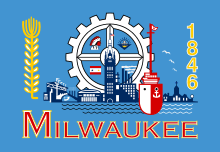
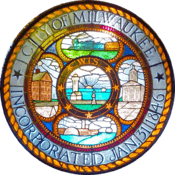

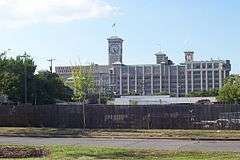
.jpg)
